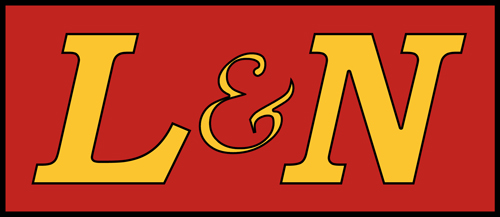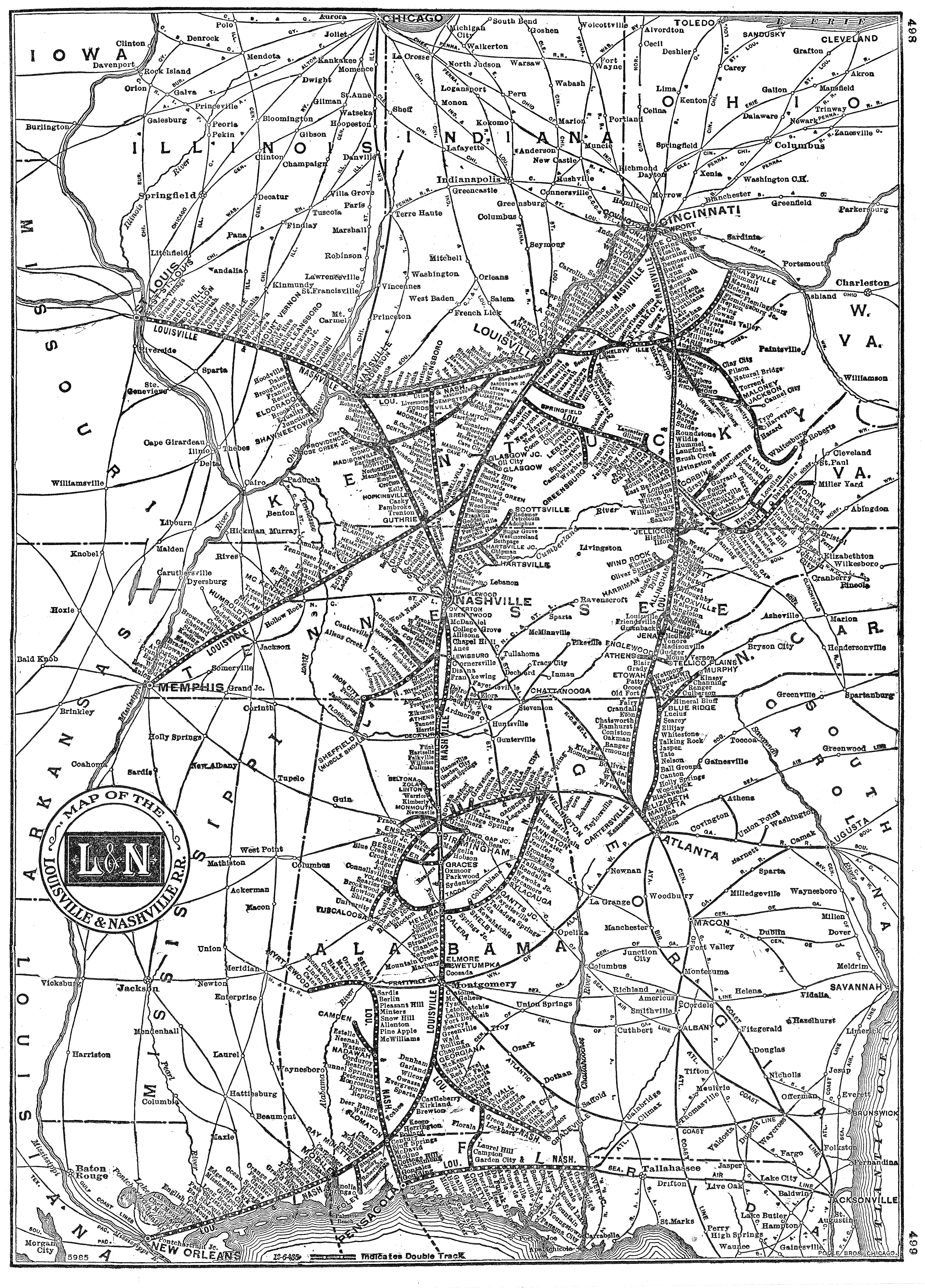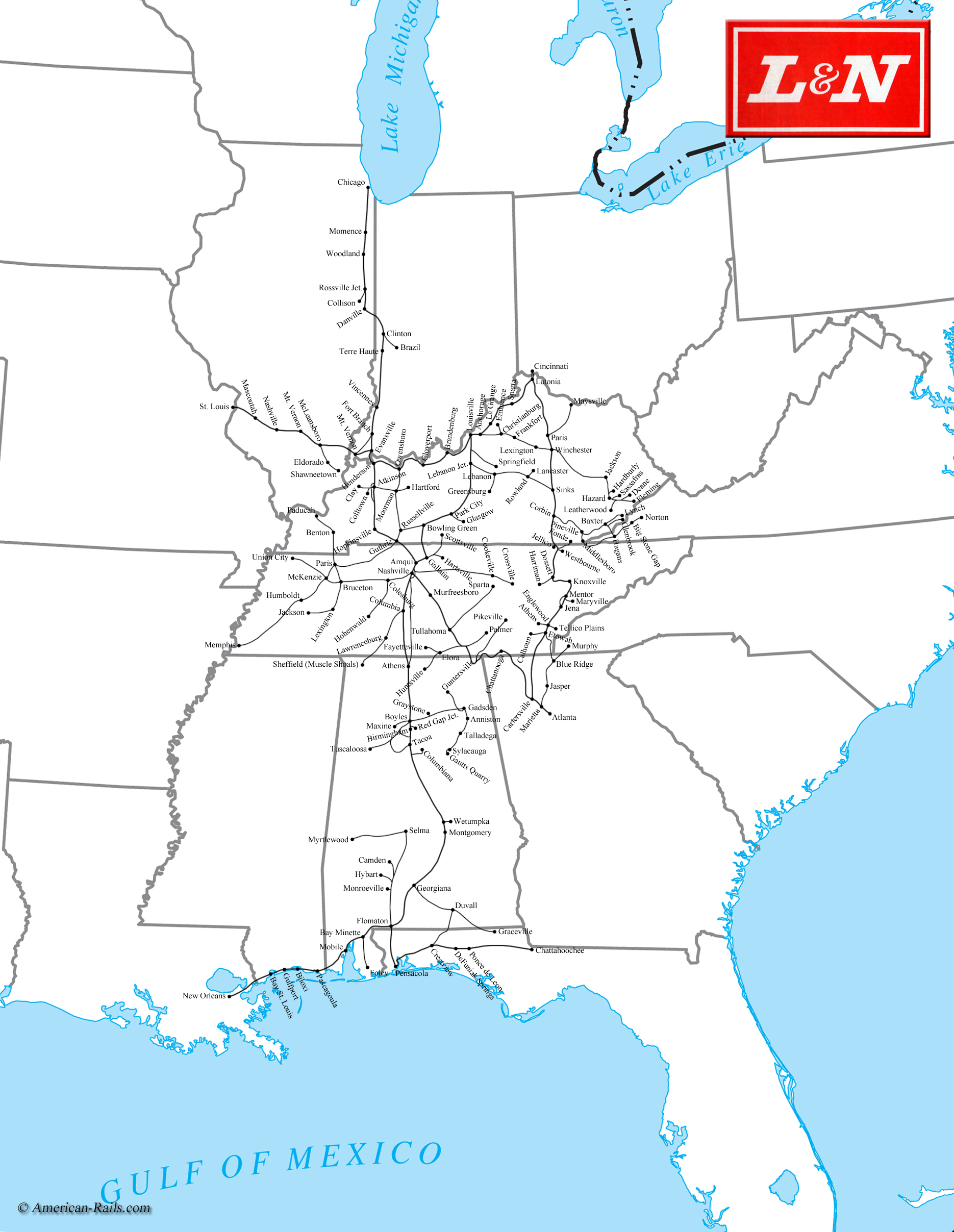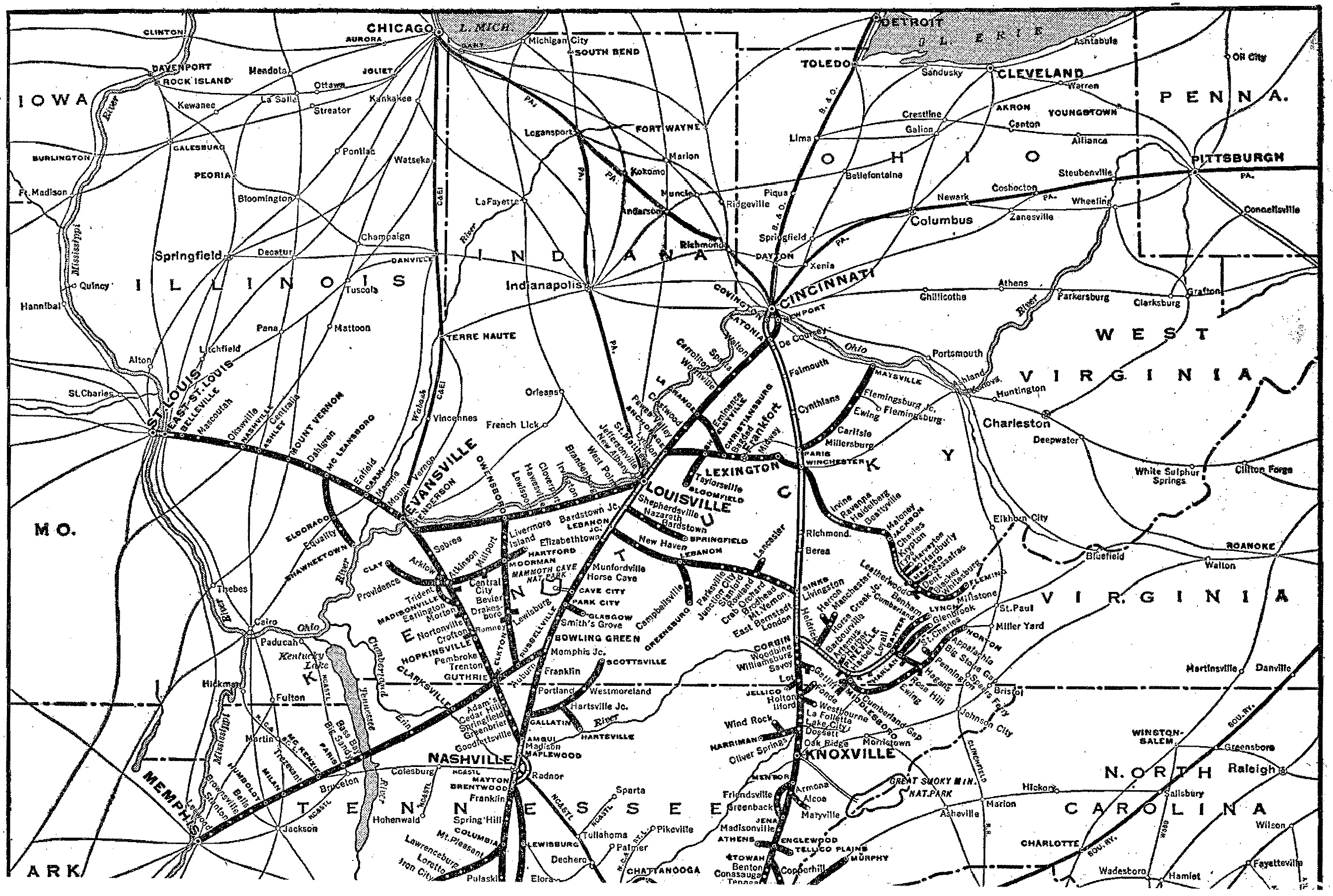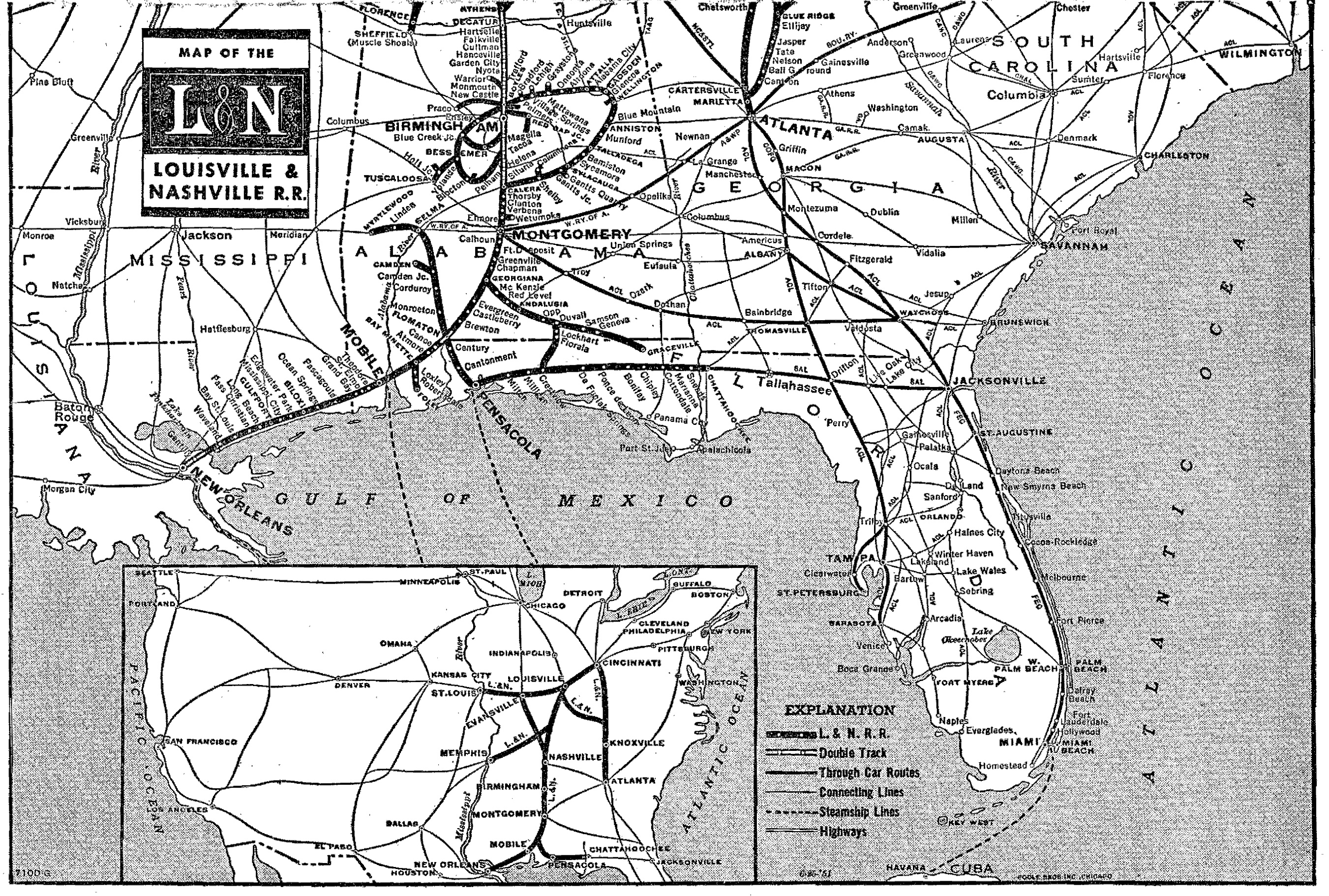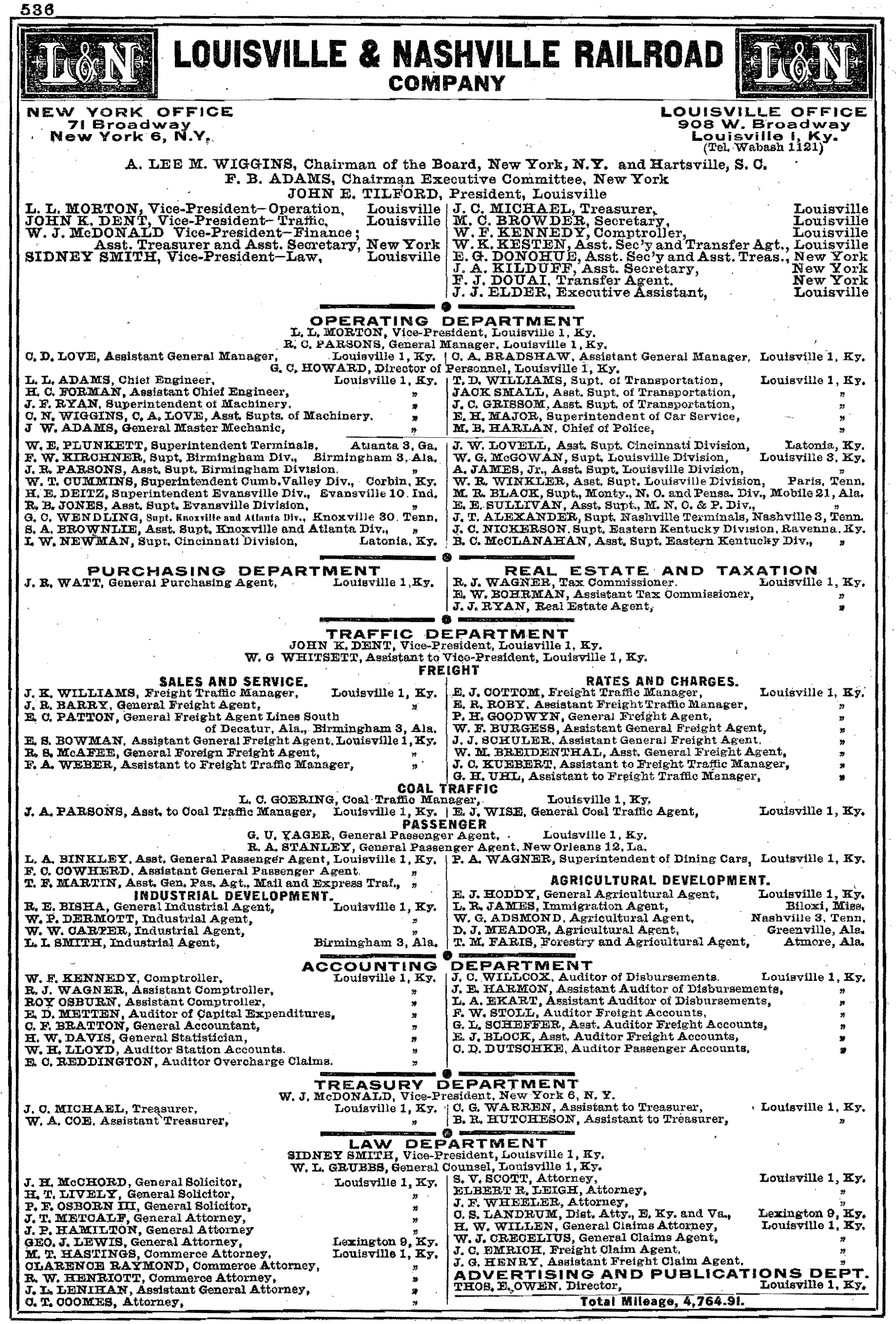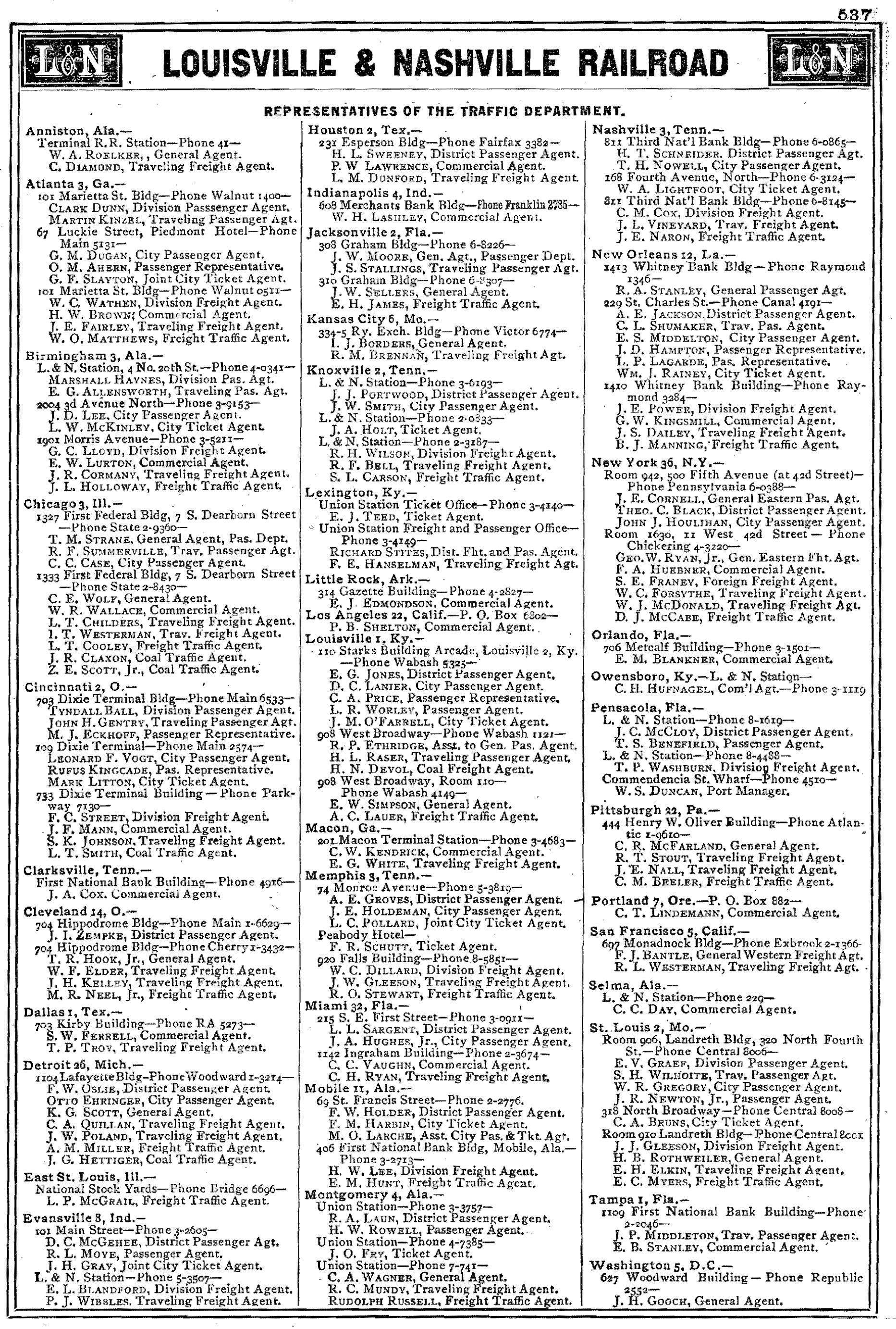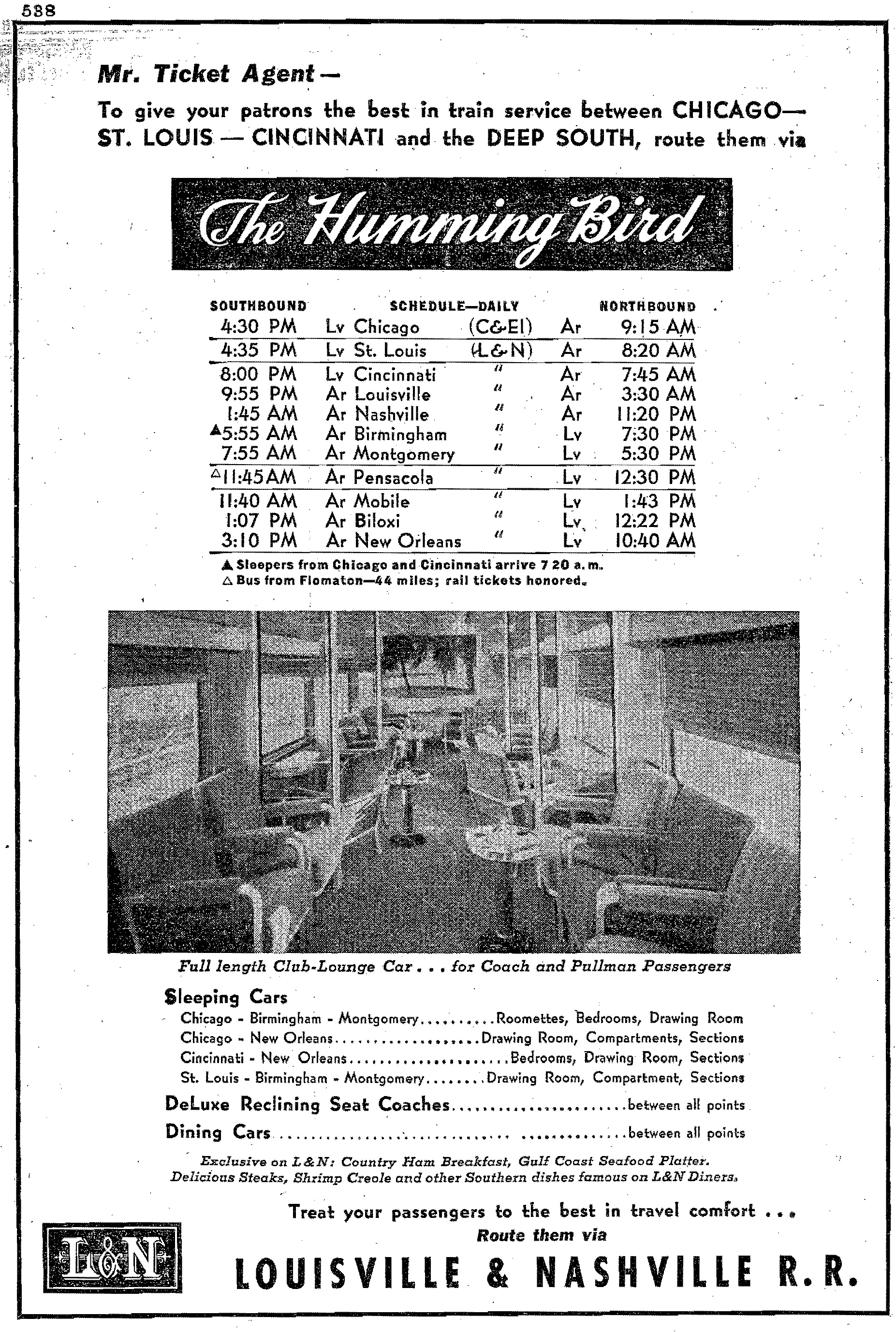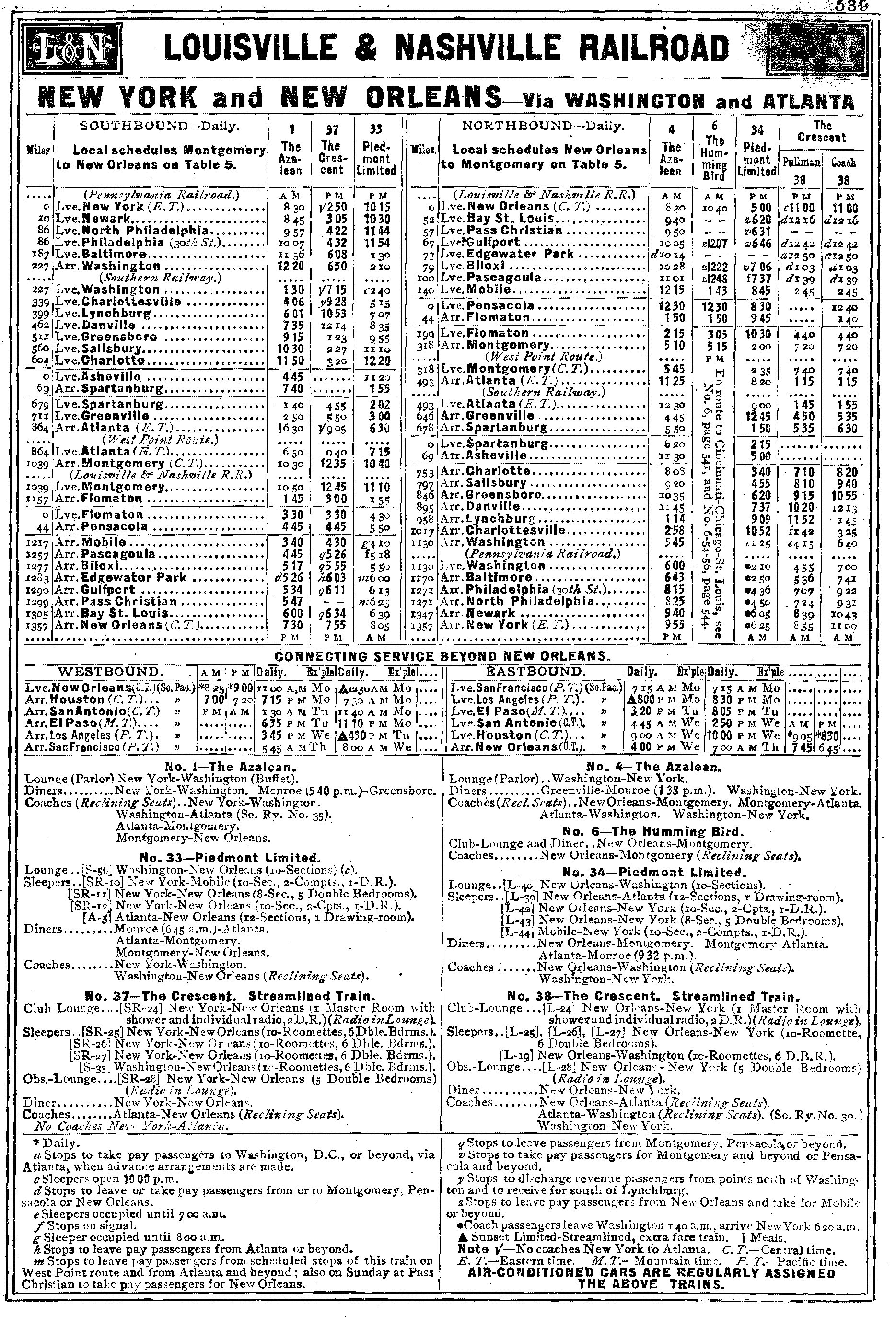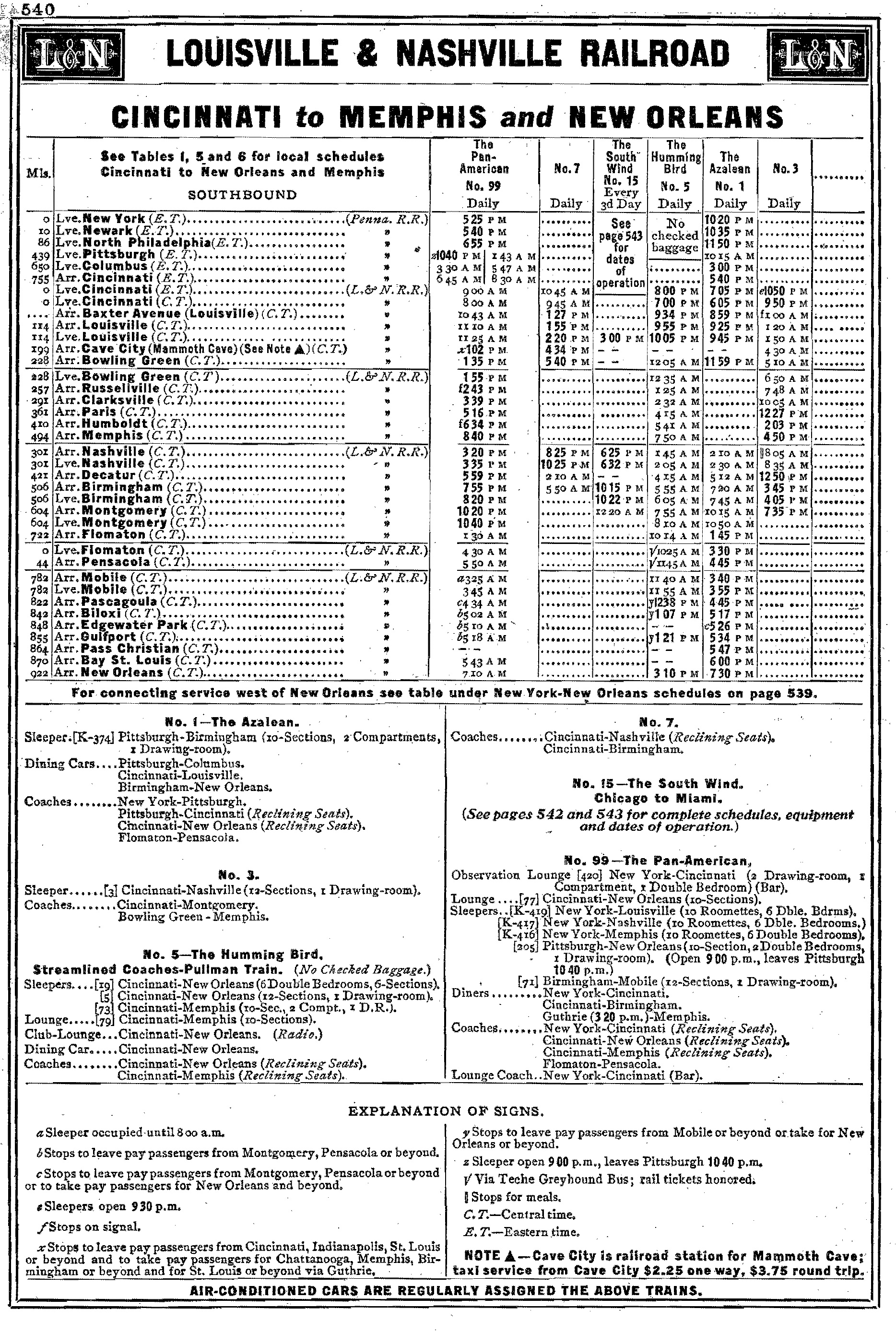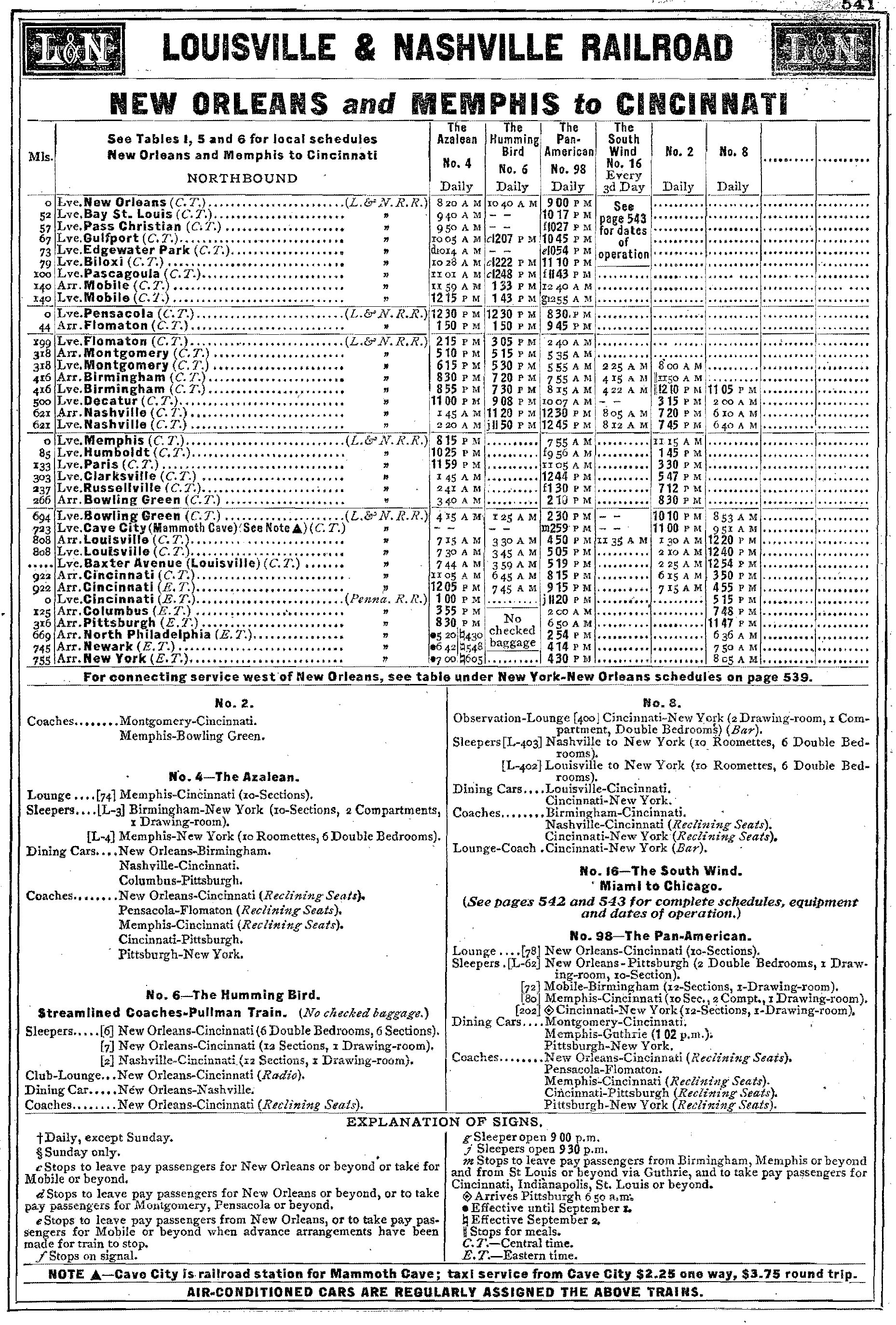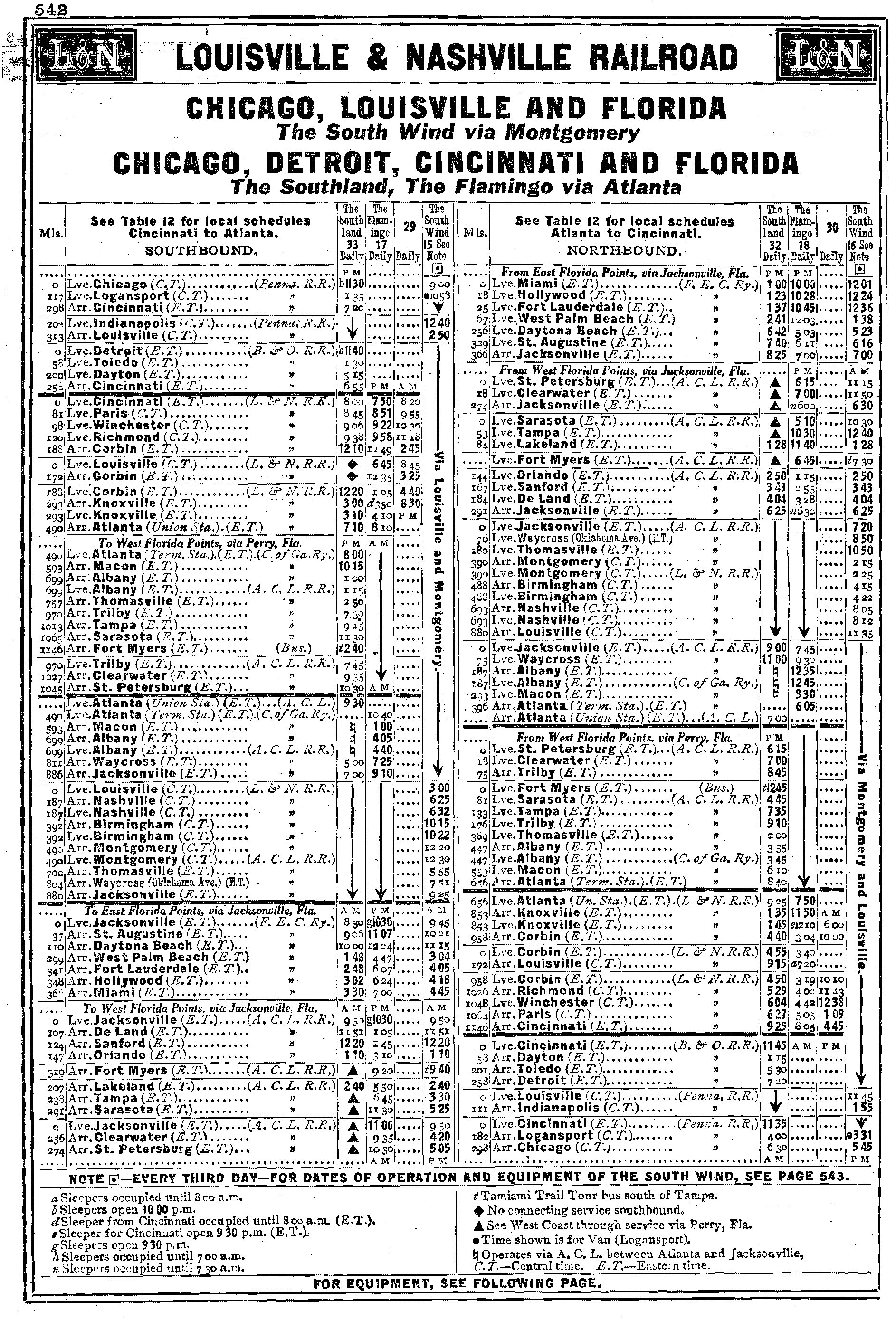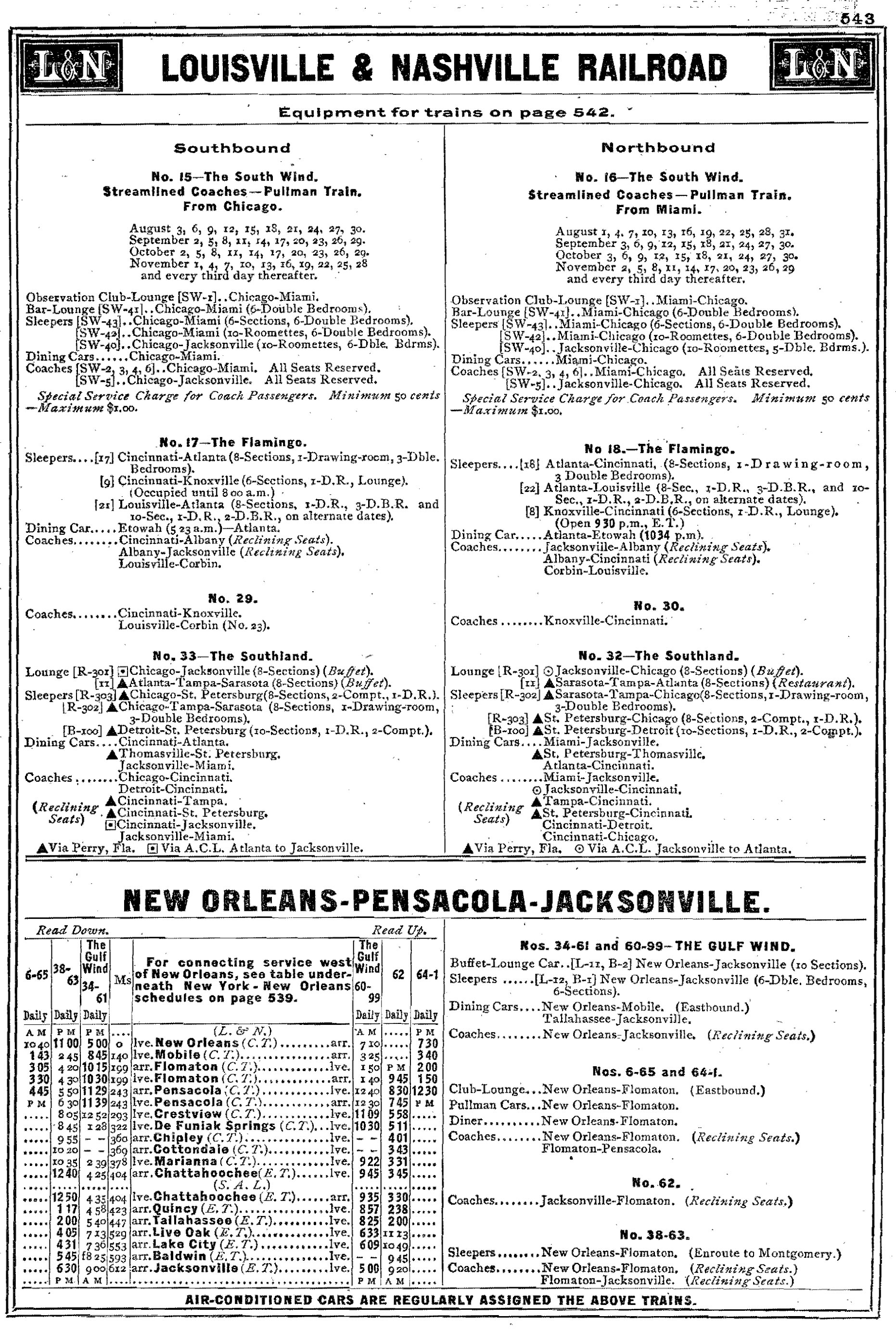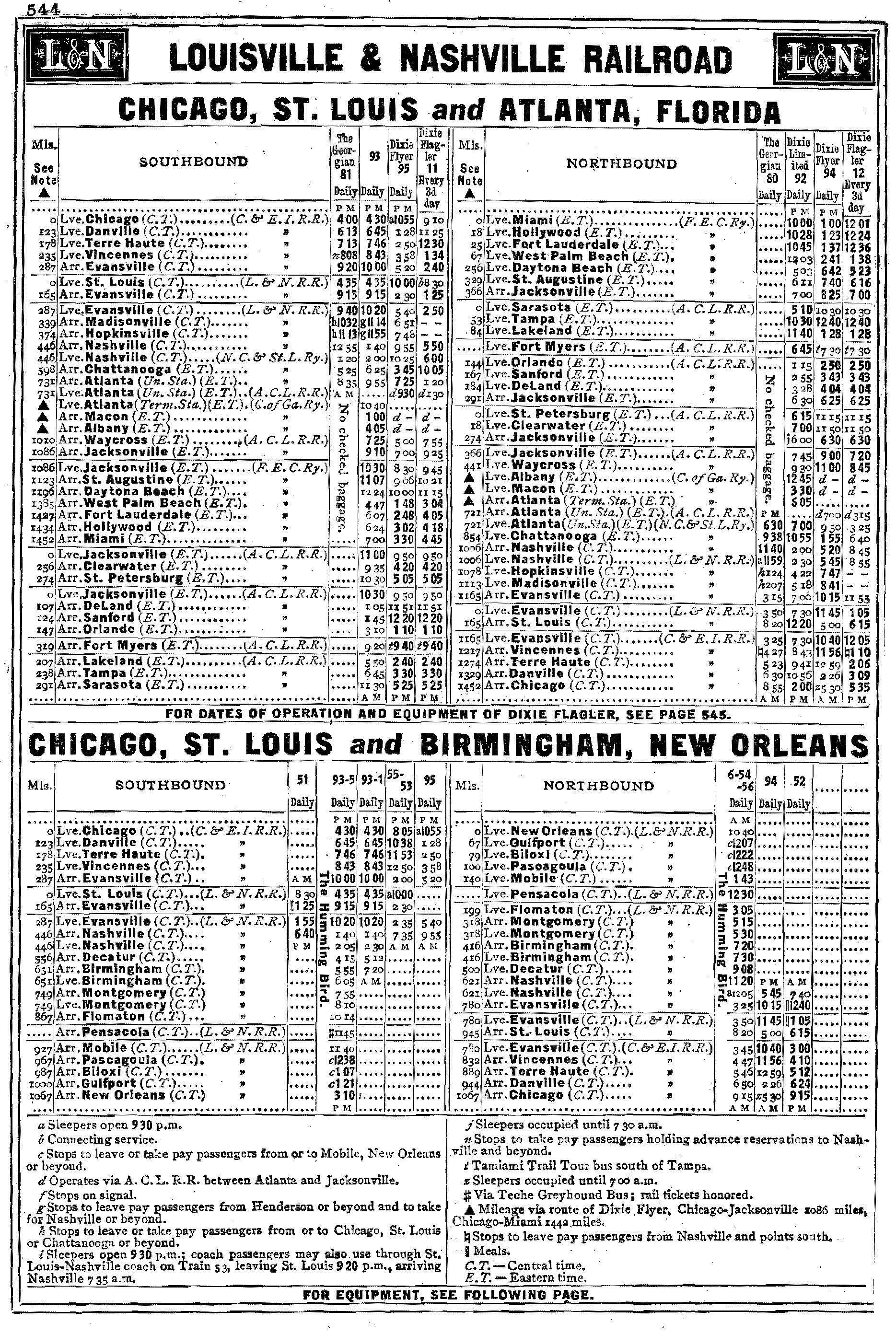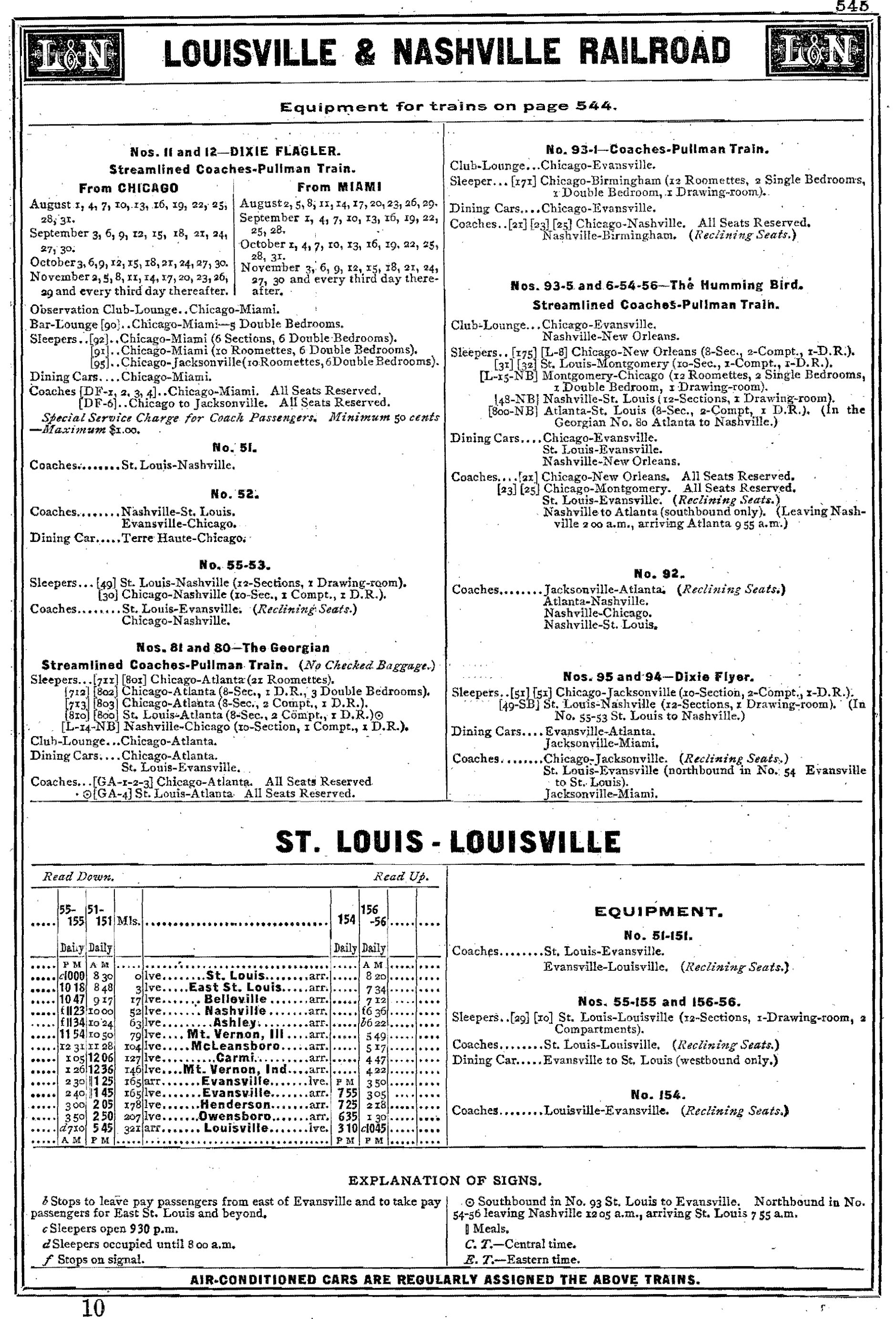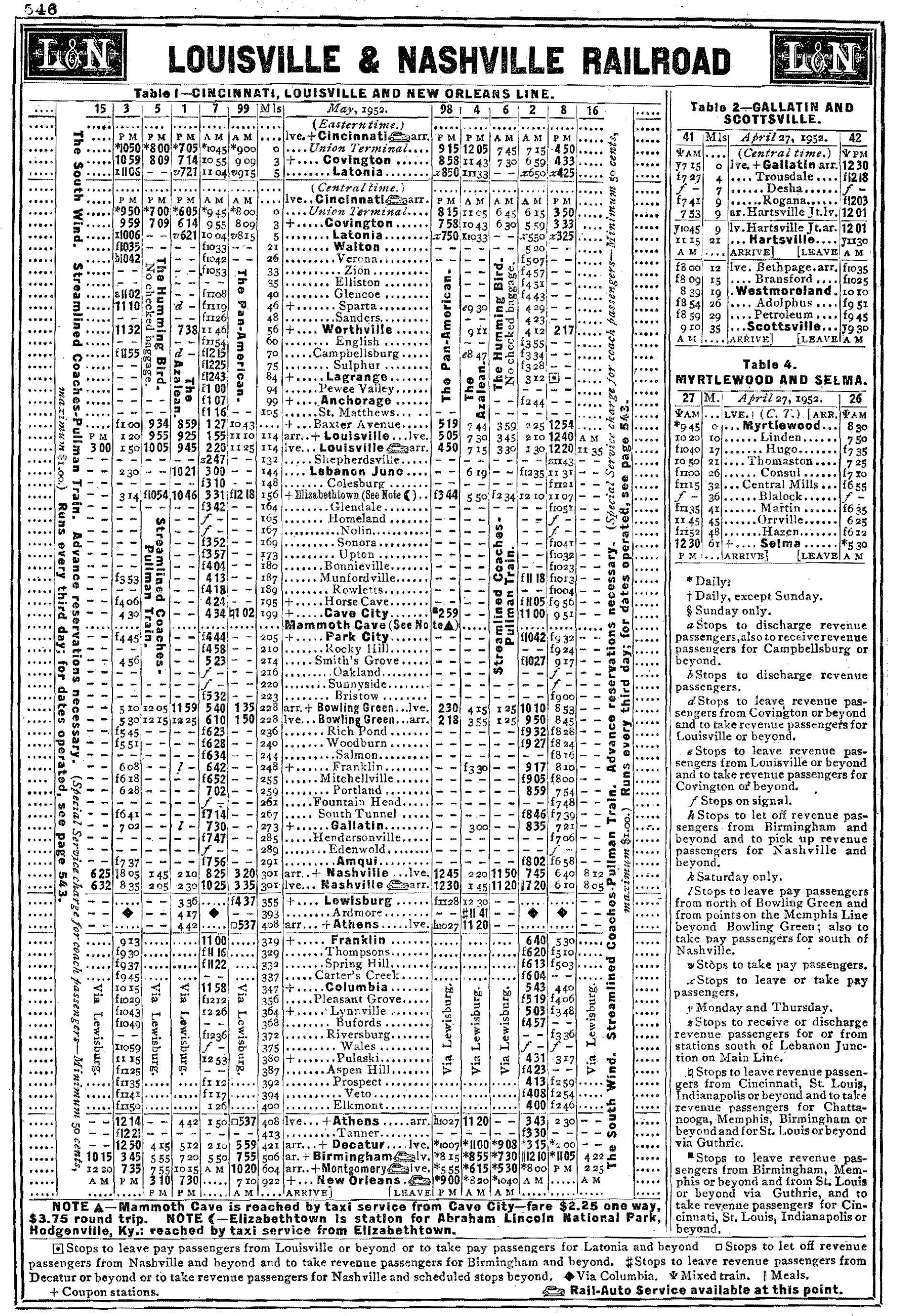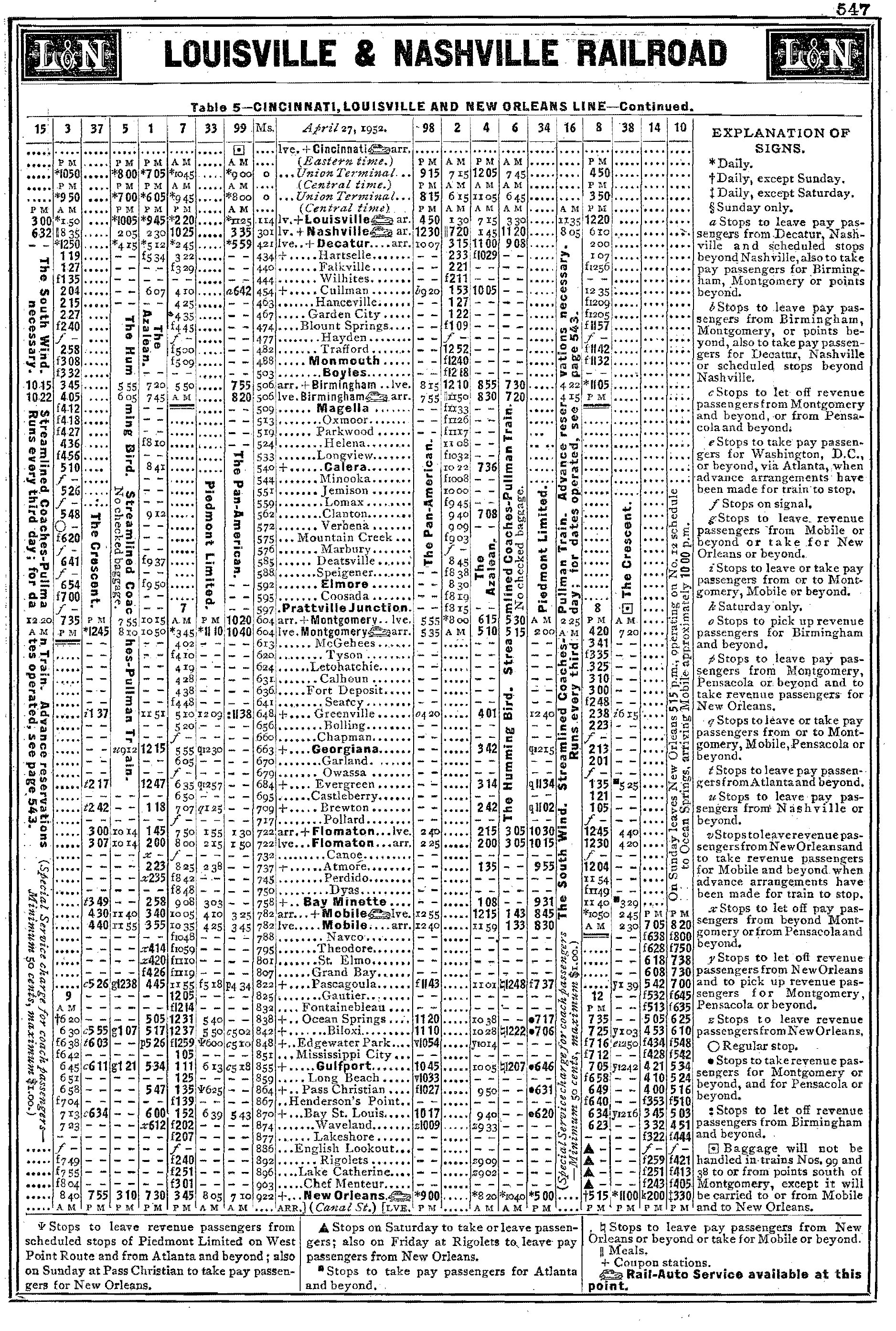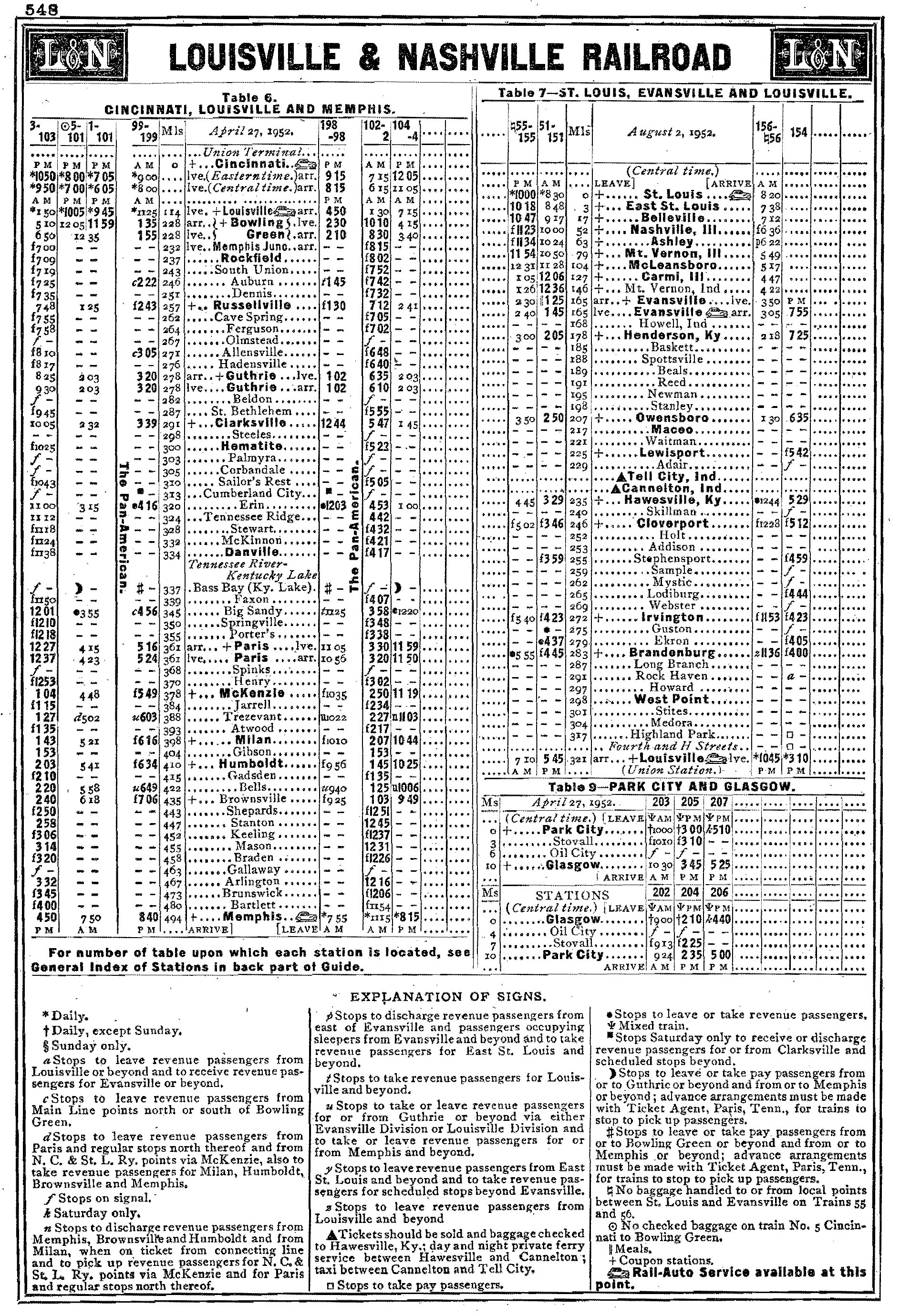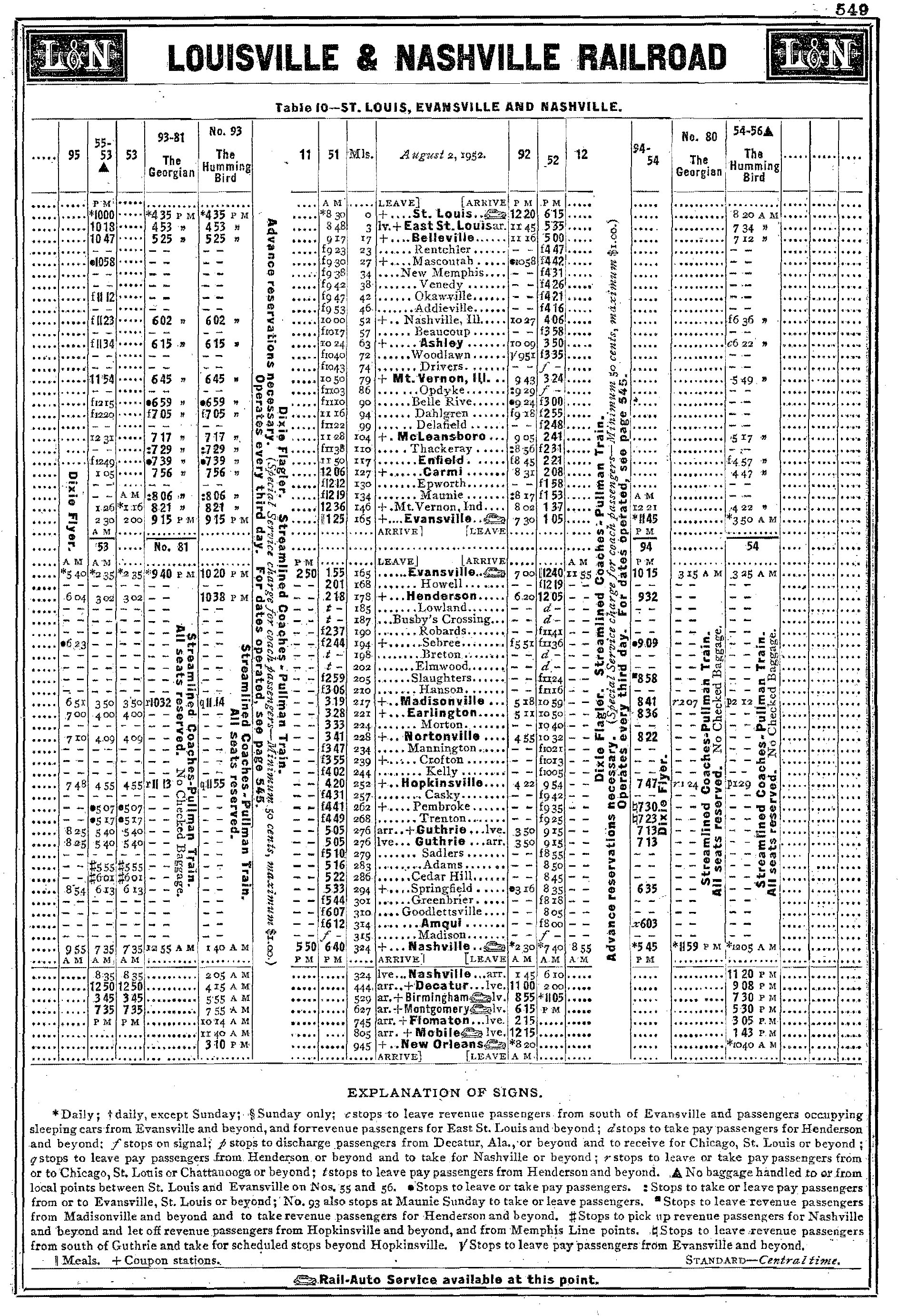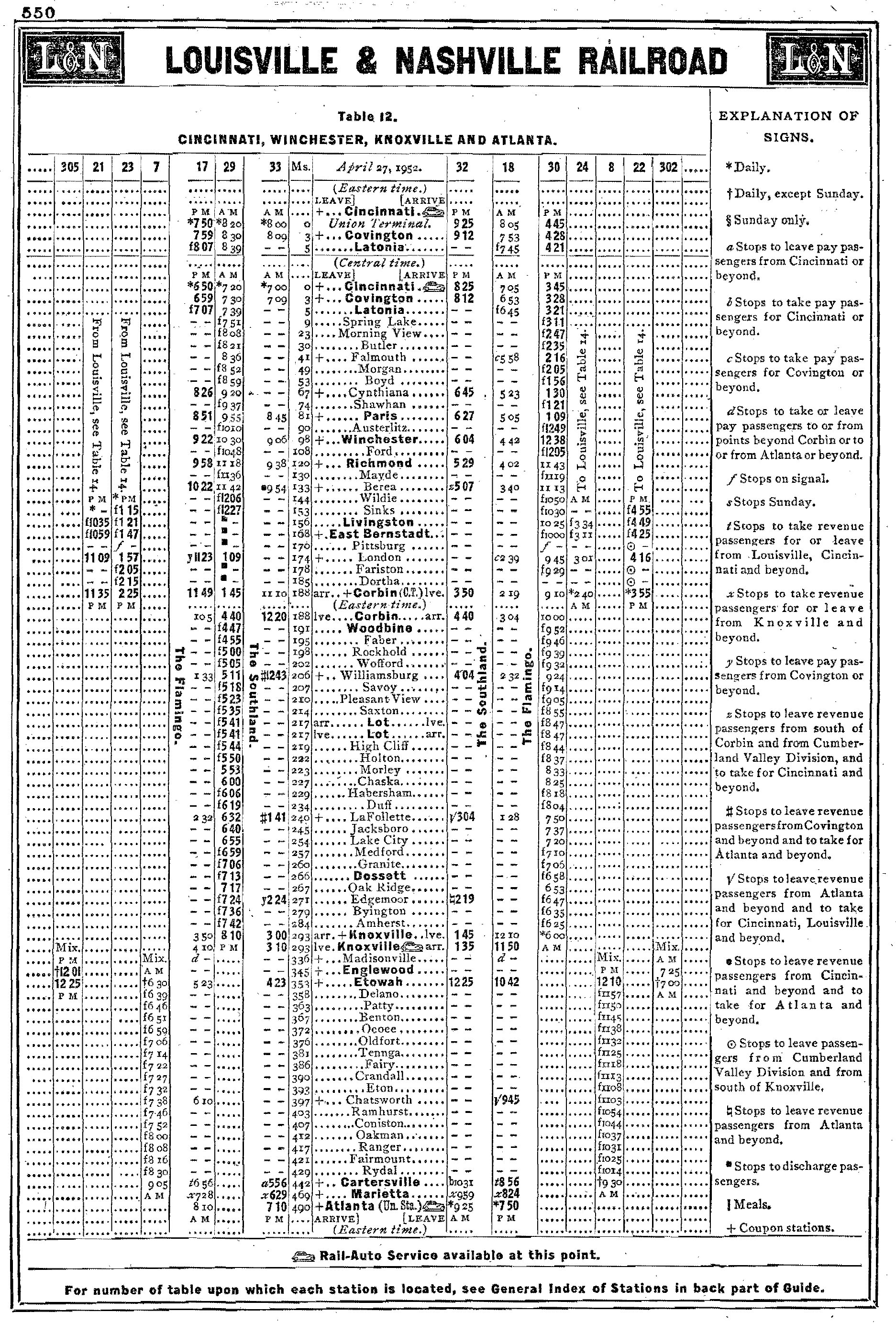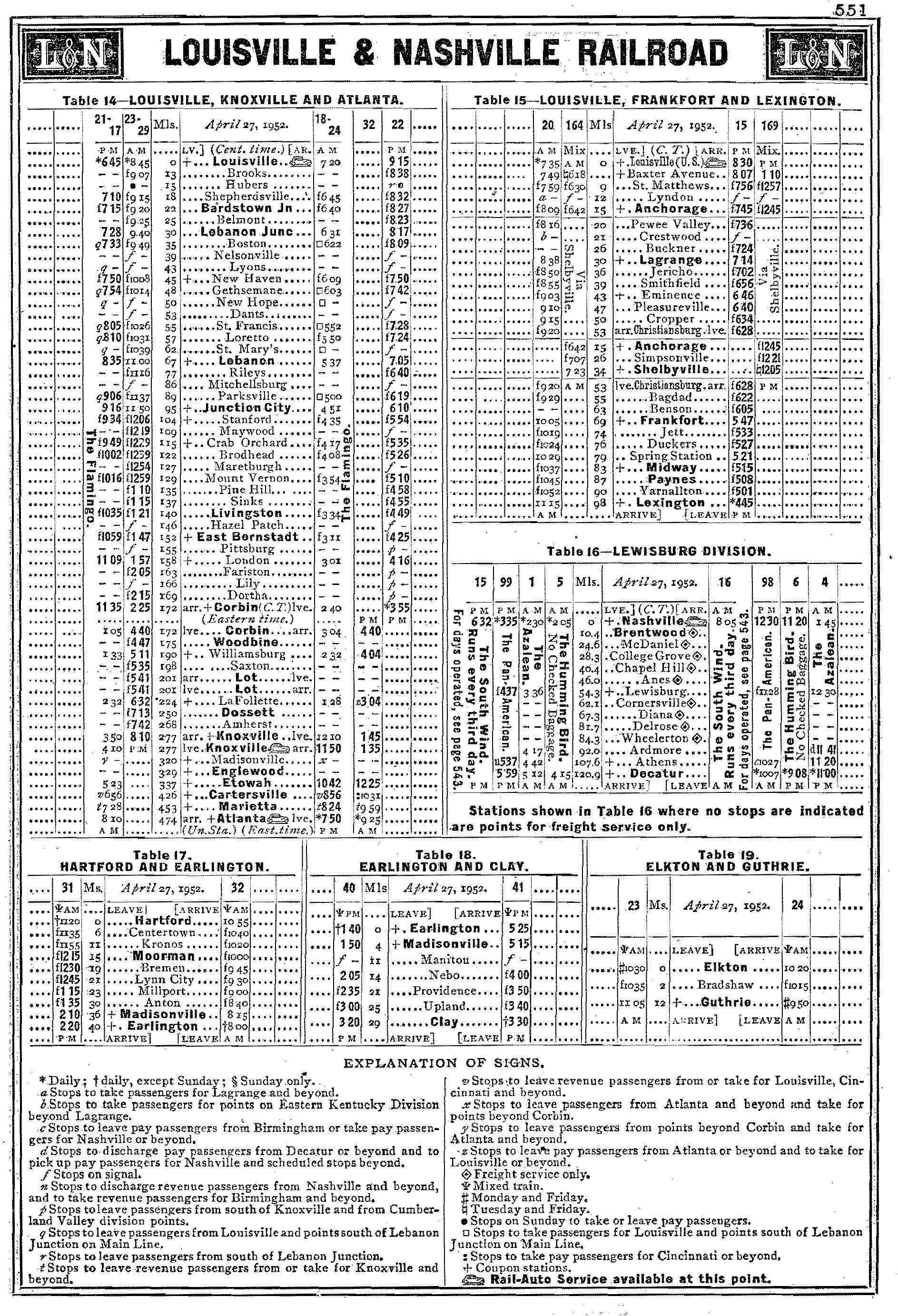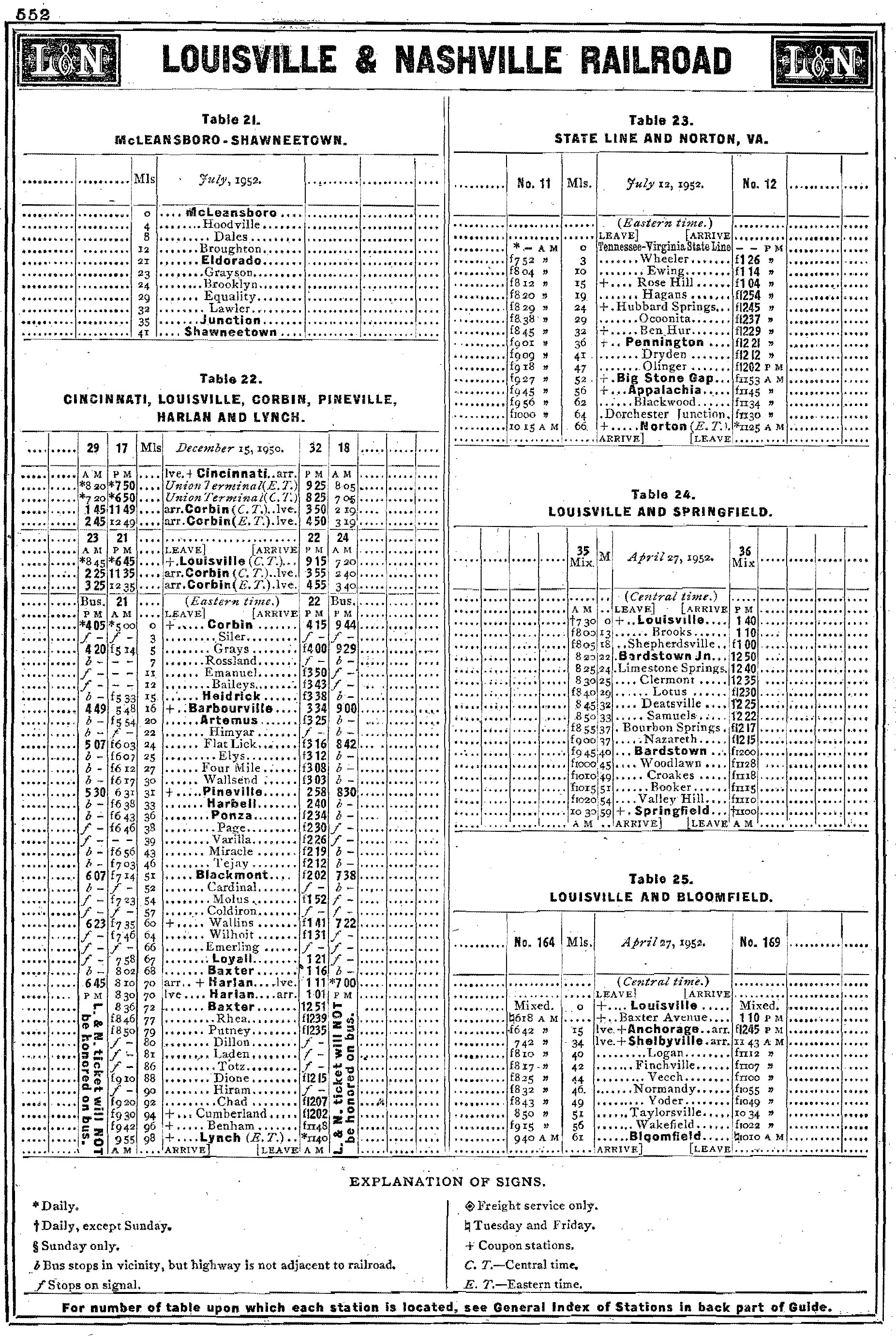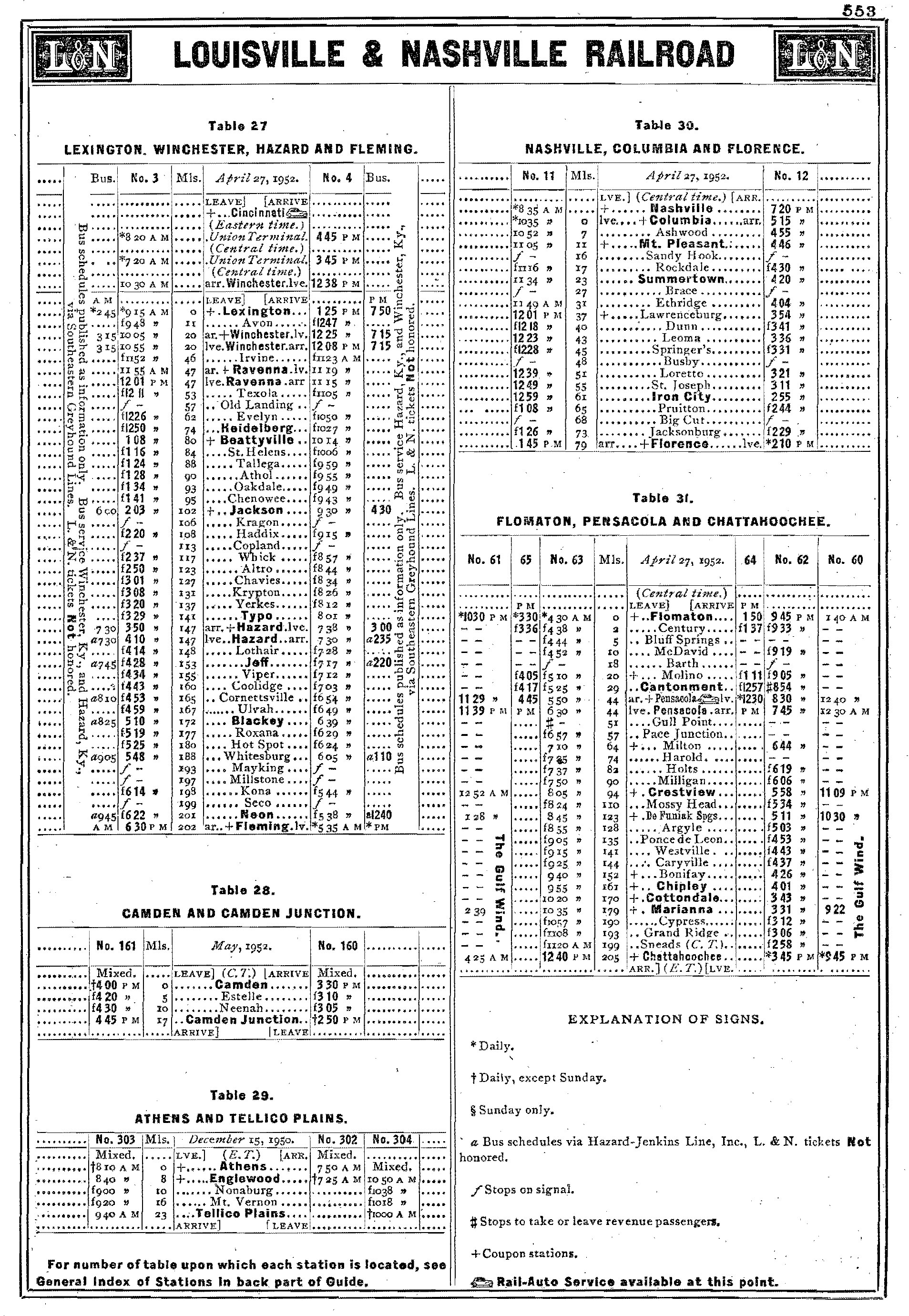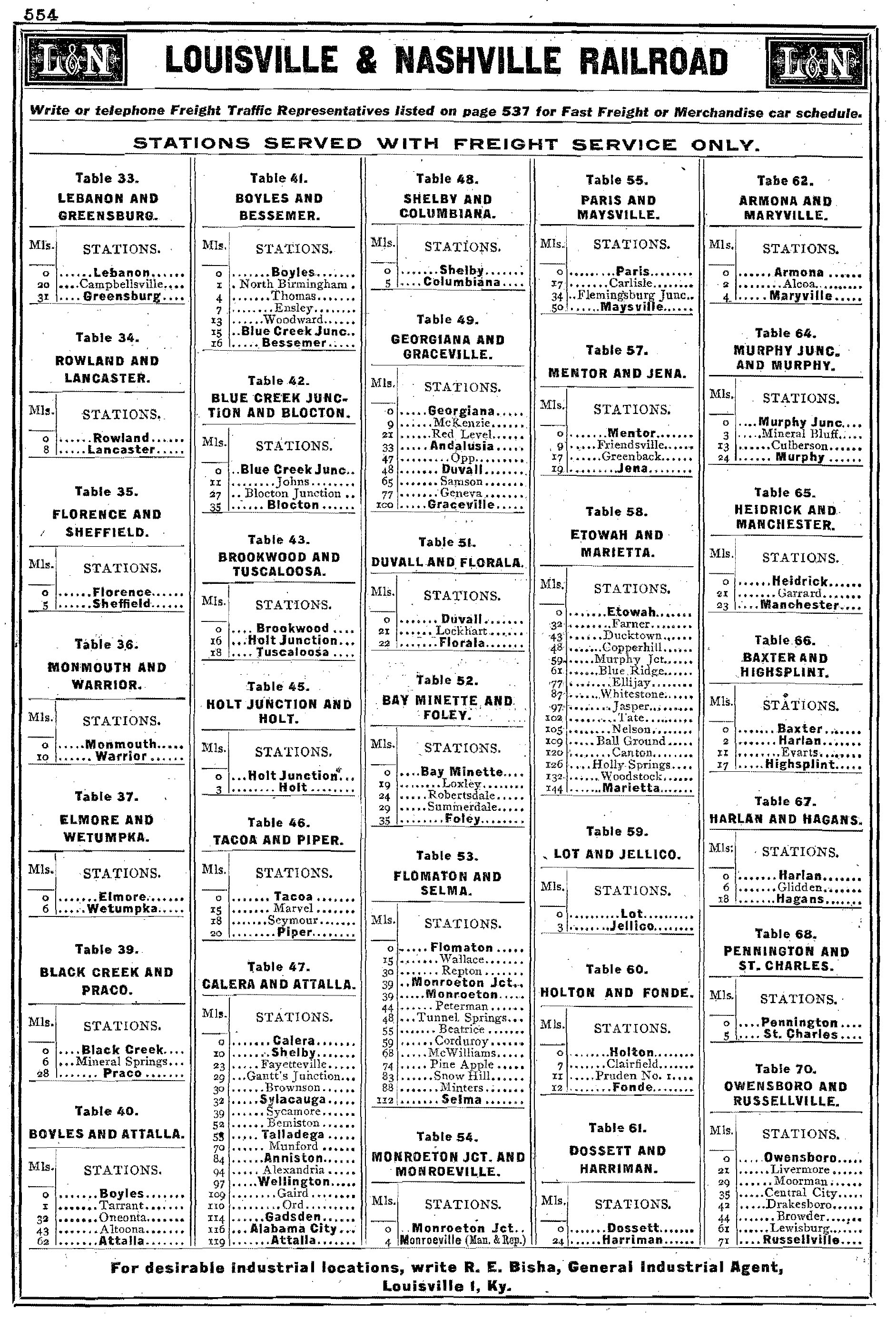Louisville and Nashville Railroad: Map, Rosters, History
Last revised: October 12, 2024
By: Adam Burns
The Louisville and Nashville Railroad served the heart of the Southeast from New
Orleans and Memphis to Atlanta and the Florida Panhandle.
It also extended to St. Louis and later reached Chicago. The L&N carries precedence as one of the few to maintain its originally chartered name, operating for more than 120 years as the Louisville & Nashville.
It all began during the 1850s; through a combination of new construction and acquisition the road blossomed into a network of nearly 5,000 route miles.
It was blessed with good management and thanks to a diverse traffic base, ranging from coal to general merchandise, sustained a strong level of profitability.
During the early 1900s it was acquired by the Atlantic Coast Line and later went on to form part of the Family Lines System.
This marketing consortium included several other carriers that eventually became the short-lived Seaboard System of the early 1980s.
That decade witnessed Seaboard added to the burgeoning CSX Transportation empire. Today, many of L&N's principal routes remain in use by the Class I.
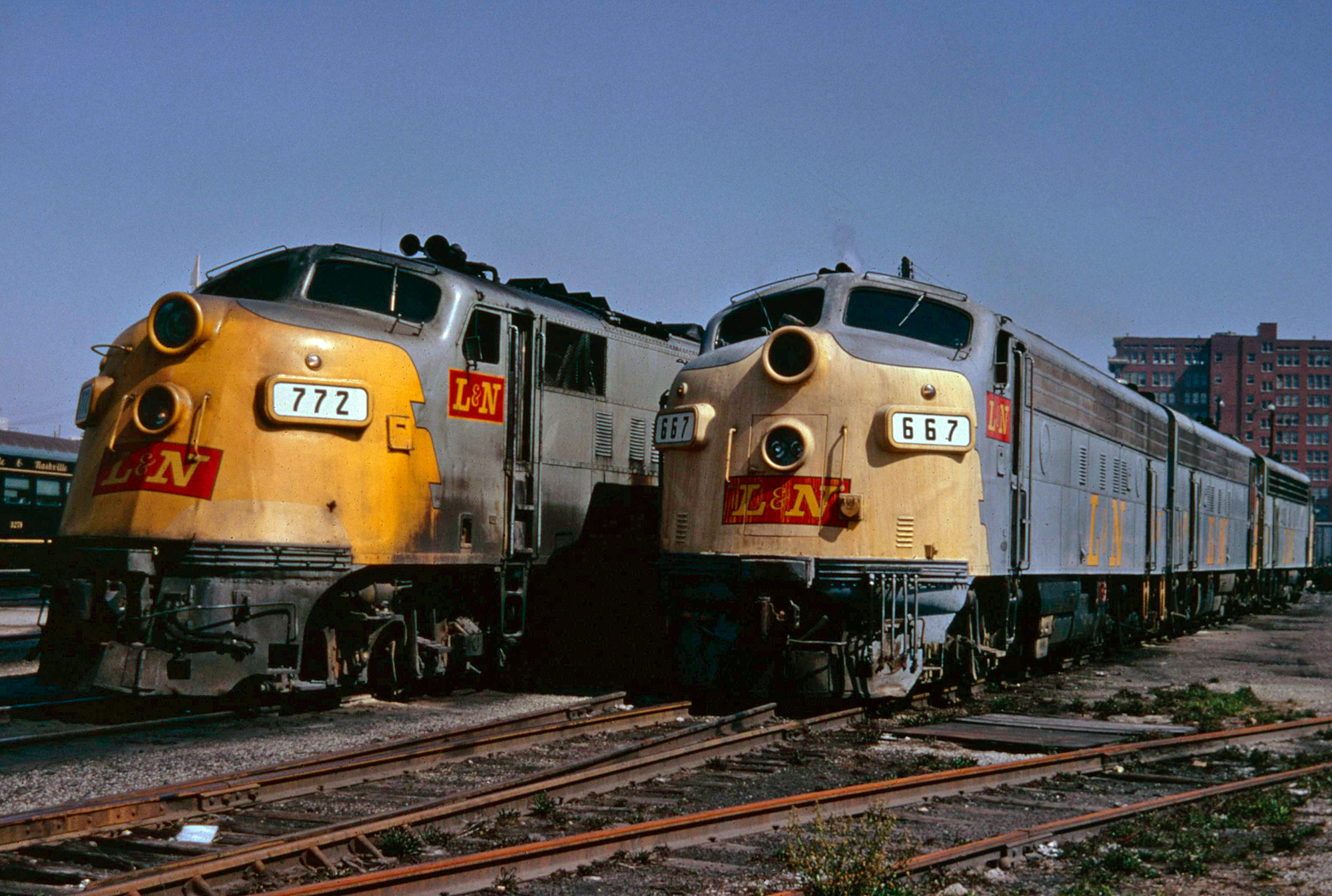 Louisville & Nashville E6A #772 and FP7 #667 await their next assignments in Louisville, Kentucky on August 24, 1962. American-Rails.com collection.
Louisville & Nashville E6A #772 and FP7 #667 await their next assignments in Louisville, Kentucky on August 24, 1962. American-Rails.com collection.History
According to the Louisville & Nashville Railroad Historical Society the Louisville & Nashville Railroad was created on March 5, 1850 when the state of Kentucky issued a charter for the company "...to build a railroad between Louisville, Kentucky, and the Tennessee state line in the direction of Nashville."
A little more than a year later a similar proclamation was granted through Tennessee on December 4, 1851 which gave the L&N legal authority to construct a line from Louisville to Nashville.
At A Glance
Cincinnati - Louisville - Nashville - Birmingham - Montgomery - Mobile - New Orleans Nashville - Evansville, Indiana - St. Louis Louisville - Evansville Bowling Green - Memphis Cincinnati - Knoxville - Atlanta Flomaton, Alabama - Chattahoochee, Florida Anchorage - Lexington - Hazard, Kentucky Corbin - Baxter, Kentucky Lebanon Junction - Sinks, Kentucky Winchester - Fleming, Kentucky Nashville - Chattanooga - Atlanta | |
Freight Cars: 59,077 Passenger Cars: 483 | |
While no one knew it at that time one of the most successful railroads in American history had been born. It took some time to secure funding but the road finally began construction in May of 1853.
The L&N's first segment officially opened on August 25, 1855 and work proceeded quickly to push rails southward towards Tennessee.
After four years of additional labor the railroad's charter was completed when it opened to Nashville on October 27, 1859. Unfortunately, the Civil War halted additional growth and the conflict was particularly harsh for the L&N.
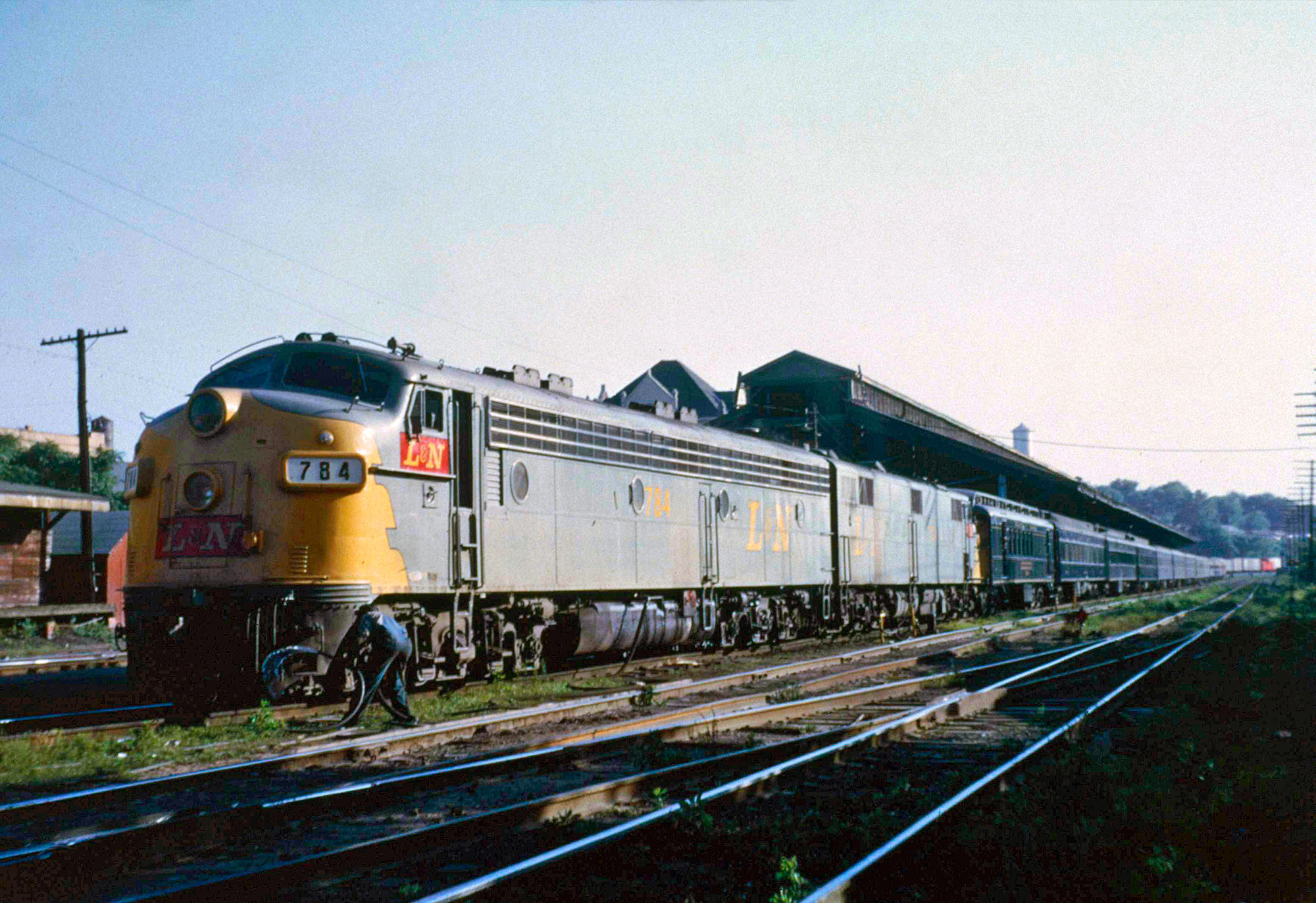 Louisville & Nashville E8A #784 and an E6A await departure from Montgomery Union Station with train #4, bound for Cincinnati, on the late afternoon of May 16, 1964. American-Rails.com collection.
Louisville & Nashville E8A #784 and an E6A await departure from Montgomery Union Station with train #4, bound for Cincinnati, on the late afternoon of May 16, 1964. American-Rails.com collection.As Mike Schafer notes in his book, "Classic American Railroads," its lines ran through both the North and South; Kentucky was a member of the Union while Tennessee's loyalties lay with the Confederacy.
Its trackage was destroyed by both sides (the Baltimore & Ohio, whose main line ran through the heart of the fighting in northern Virginia/West Virginia and Maryland dealt with a similar issue). Financially, the L&N weathered the war relatively well and exited the conflict in good condition.
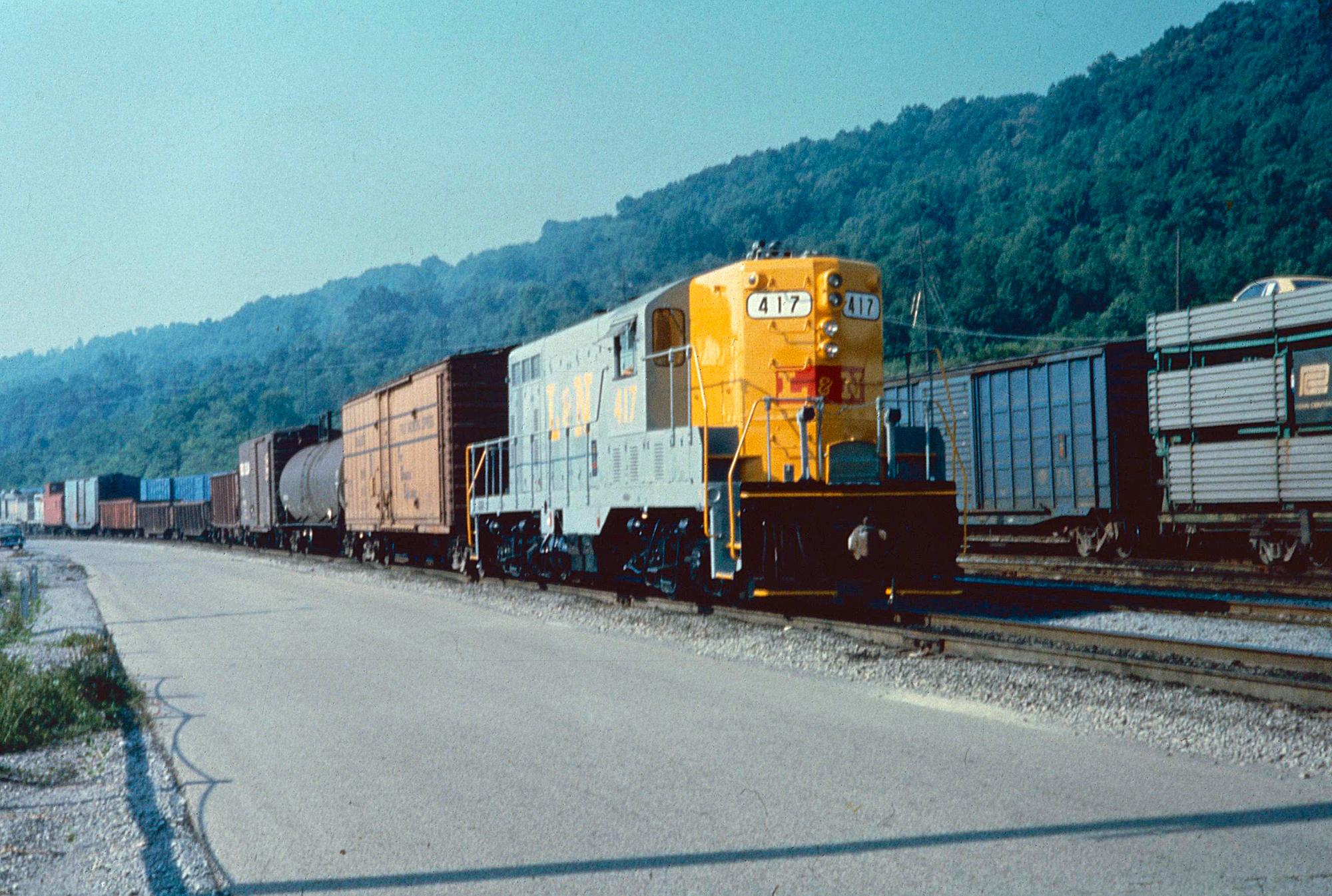 A freshly repainted Louisville & Nashville GP7, #417, heads through Decoursey Yard in Decoursey, Kentucky with a short train on the morning of July 30, 1973. American-Rails.com collection.
A freshly repainted Louisville & Nashville GP7, #417, heads through Decoursey Yard in Decoursey, Kentucky with a short train on the morning of July 30, 1973. American-Rails.com collection.Expansion
It was soon expanding again as the railroad's growth continued into the following decade, eyeing a direct route to the Gulf Coast.
In 1872, through a series of small acquisitions it reached Montgomery, Alabama. The area around present-day Birmingham contained some coal and iron deposits, which spawned a local steel industry that helped fuel L&N's further southward expansion.
In 1881, it finally reached New Orleans via Mobile, Alabama via the Montgomery & Mobile and New Orleans, Mobile & Texas. Two years later, in 1883, it opened a 170-mile corridor from Pensacola to Chattahoochee, Florida, its furthest reach into the Sunshine State.
Logo
The railroad's growth at this time witnessed a flurry of activity in all different directions.
According to the book, "Limiteds, Locals, And Expresses In Indiana, 1838-1971" by author Craig Sanders, the L&N acquired its extension to St. Louis when it took over two separate components of the St. Louis & Southeastern:
- In 1879 it purchased the road's Kentucky and Tennessee Divisions between Nashville and Henderson, Kentucky.
- Then a year later, on May 1, 1880, added the Illinois and Indiana Divisions between Henderson/Evansville and St. Louis.
The segment from Evansville/Henderson and Nashville had been built by the Evansville, Henderson & Nashville, established in 1866 and opened in April of 1871.
It was the vision of Evansville business leaders who wanted a direct rail artery to Southern markets. Following the EH&N's completion it was acquired by the StL&SE in 1872. The latter was chartered in 1869 to build from East St. Louis to Evansville, opening in late 1871.
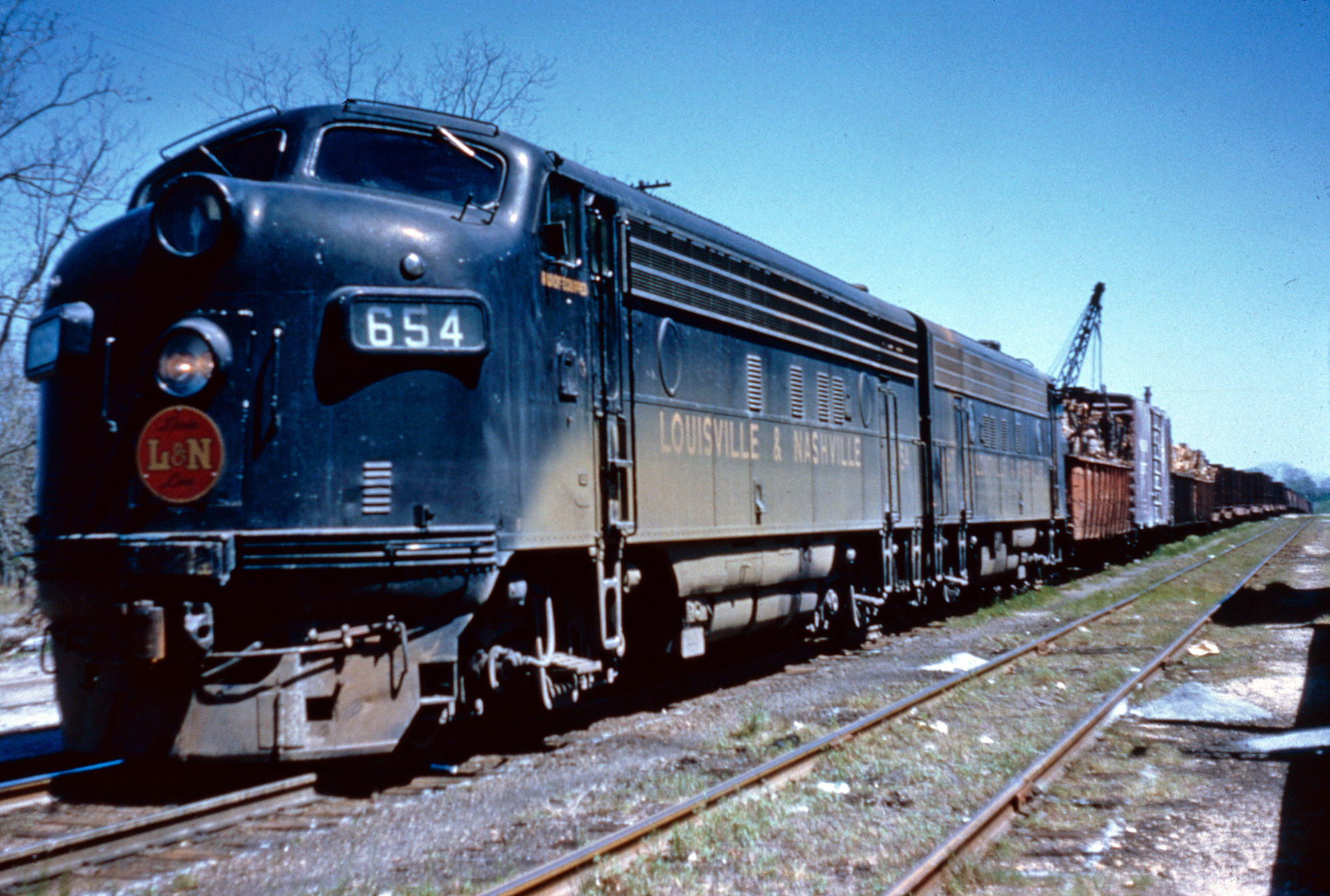 Louisville & Nashville FP7 #654, pressed into freight service, heads west near Cottondale, Florida on March 3, 1962. American-Rails.com collection.
Louisville & Nashville FP7 #654, pressed into freight service, heads west near Cottondale, Florida on March 3, 1962. American-Rails.com collection.Beyond St. Louis the L&N looked to dominate rail service across Tennessee. In 1880 it acquired long-time rival Nashville, Chattanooga & St. Louis through a hostile takeover.
The so-called Dixie Line, reached points throughout its home state such as Memphis, Chattanooga, and Nashville.
In 1890 the NC&StL leased the Western & Atlantic Railroad from the state of Georgia which gave it a direct connection to Atlanta.
Despite L&N's takeover, the Dixie Line remained largely independent with locomotives numbered and rostered independently.
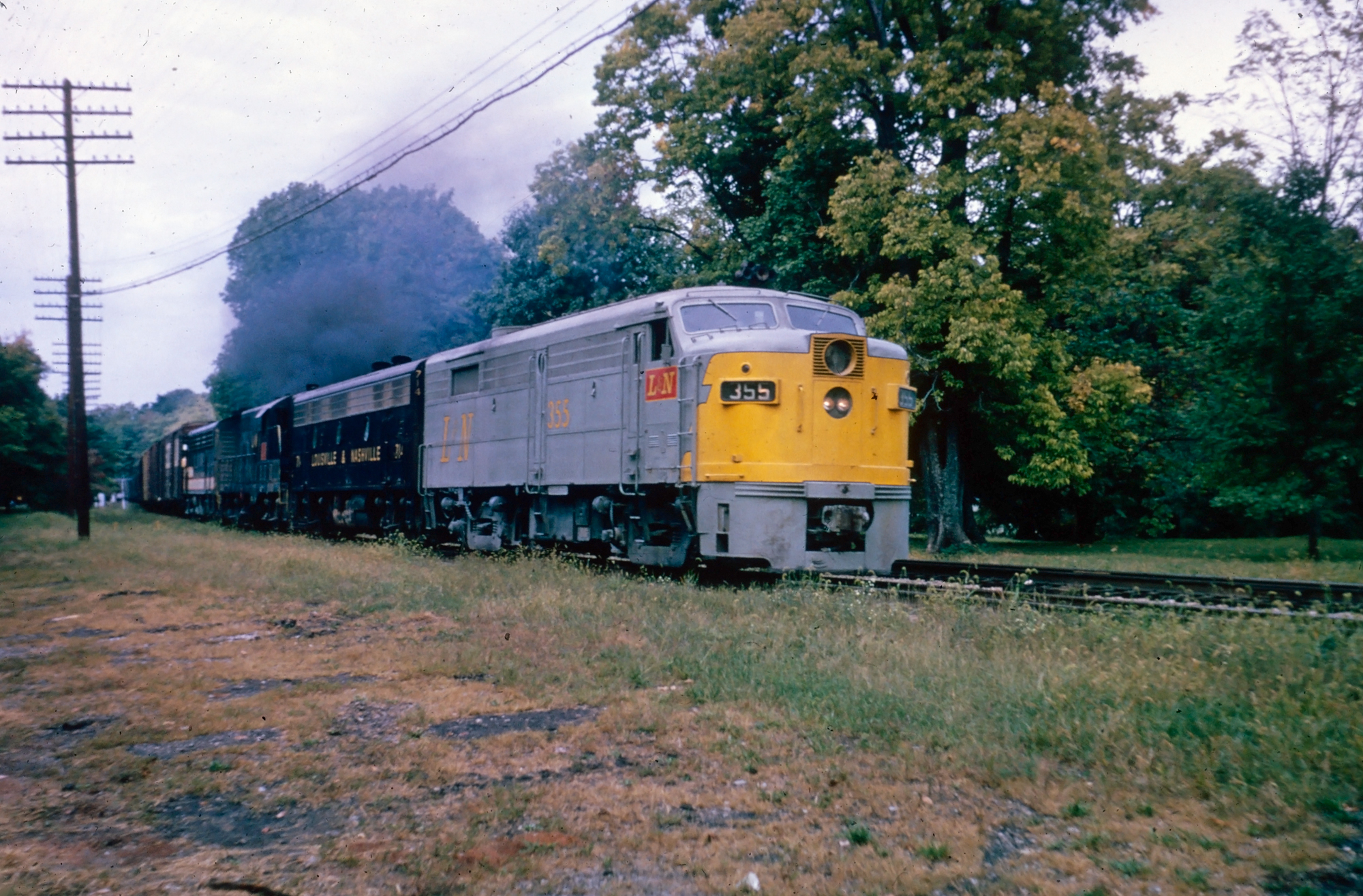 Louisville & Nashvile FA-2 #355 - along with an F7B, GP7, and F7A - lead a freight train through Anchorage, Kentucky on September 26, 1964. Photographer unknown. American-Rails.com collection.
Louisville & Nashvile FA-2 #355 - along with an F7B, GP7, and F7A - lead a freight train through Anchorage, Kentucky on September 26, 1964. Photographer unknown. American-Rails.com collection.In addition, early first generation diesels wore a separate livery. It remained this way until August 30, 1957 when the NC&StL was formerly merged into the Louisville & Nashville.
In 1881 the L&N gained control of the Louisville, Cincinnati & Lexington, which provided it access to Cincinnati, Ohio as well as a branch to Lexington via the state capital at Frankfort.
During early 1882 the railroad appointed Milton H. Smith as vice-president and traffic manager. He would soon ascend to the presidency and oversee L&N's expansion through the end of the 19th, and into the early 20th century.
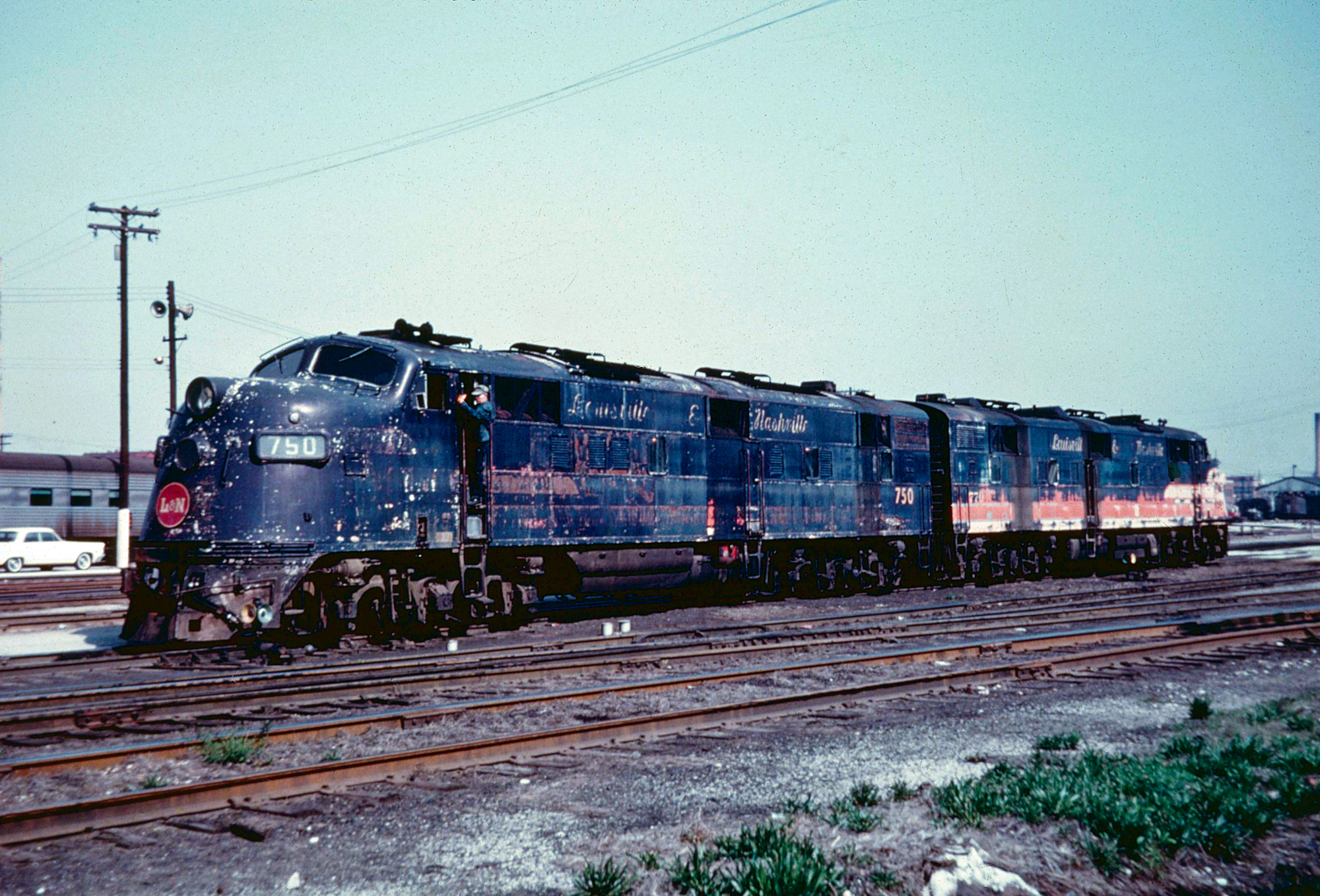 A pair of neglected Louisville & Nashville E6A's, #750 and #770, roll through the yard in Louisville, Kentucky, circa 1964. American-Rails.com collection.
A pair of neglected Louisville & Nashville E6A's, #750 and #770, roll through the yard in Louisville, Kentucky, circa 1964. American-Rails.com collection.With a route to Cincinnati now established it focused efforts in eastern Kentucky. Heading south from the Queen City it extended to Livingston, via Lebanon, and Jellico, Tennessee by 1883 where a connection was made with what later became the Southern Railway. The ultimate goal was Atlanta and a more direct route to Cincinnati.
Much of this growth, once more, came through acquisition. It picked up the Kentucky Central Railroad in 1891 between Covington, Kentucky and Livingston then constructed a new line into Knoxville, connecting there with the Knoxville Southern and Marietta & North Georgia.
It later purchased these roads outright in 1902, offering a link to Marietta, Georgia.
Finally, as previously mentioned, it arrived in Atlanta via the Western & Atlantic, a system leased to subsidiary NC&StL in 1890. With the L&N’s through routes in place by 1905 the railroad shifted focus towards building up its freight business.
System Map (1940)
Since lines were already located near the rich coalfields of eastern Kentucky it seemed logical to expand into these regions.
The move also opened connections with the Norfolk & Western, in the process of constructing a western extension from its main line at Bluefield, Virginia (near the border with West Virginia).
The L&N began work on its new route during April of 1886. It extended away from the main line at Corbin, Kentucky and headed southeast towards Middlesboro, reaching there in 1889.
System Map (1969)
It then continued east to Cumberland Gap, Tennessee before turning northeast to the small hamlet of Ewing. The branch would eventually connect with the N&W at a location known as Norton, via Big Stone Gap and Appalachia, during April of 1891.
These coalfields were extremely bountiful, so much so that four railroads eventually reached there including the N&W, L&N, Southern, and the small Interstate Railroad (constructed solely for the purpose of moving black diamonds).
The L&N acquired an entire cluster of lines here with other extensions reaching Glenbrook, Manchester, Herron, and Lynch (all located in Kentucky).
Collectively, the network was known as its Cumberland Valley Division. Traffic grew so strongly that it took the uncommon step of double-tracking the corridor between Corbin and Loyall (68 miles) in 1926.
In 1910 the L&N further expanded its coal business through the Lexington & Eastern Railroad running between the state capital and Fleming, near the Virginia border.
Several short branches were subsequently built here to serve additional mines. As with the Cumberland Valley Division, what became known as the EK Lines (for “Eastern Kentucky”) were also double-tracked between Winchester and Blackey.
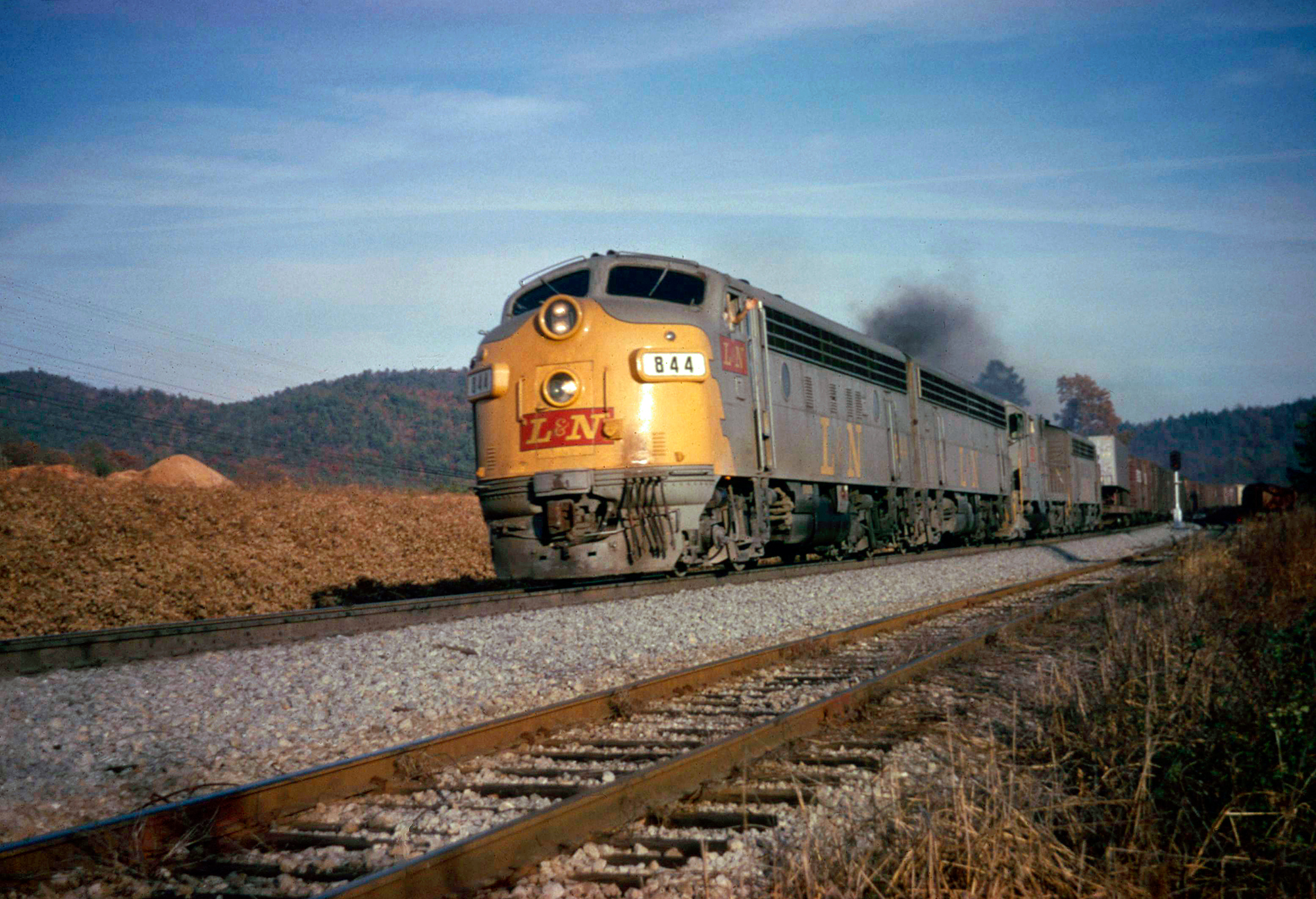 With a friendly wave from the fireman, Louisville & Nashville F7A #844 leads a general manifest westbound near Cartersville, Georgia during the fall of 1970. American-Rails.com collection.
With a friendly wave from the fireman, Louisville & Nashville F7A #844 leads a general manifest westbound near Cartersville, Georgia during the fall of 1970. American-Rails.com collection.From this point forward the railroad spent most of its resources and energies upgrading lines and its overall property. Surprisingly, the L&N never reached Chicago until 1969 when the railroad took over the Chicago & Eastern Illinois’ main line via Evansville.
The two roads had long interchanged trains here prior to this event. Two years later it purchased Indiana's Monon Railroad in 1971 and gained an additional route to the Wind City via Indianapolis.
The final system map of the L&N, as seen above, featured a spaghetti of trackage in its home states with extensions to Chicago, St. Louis, and New Orleans.
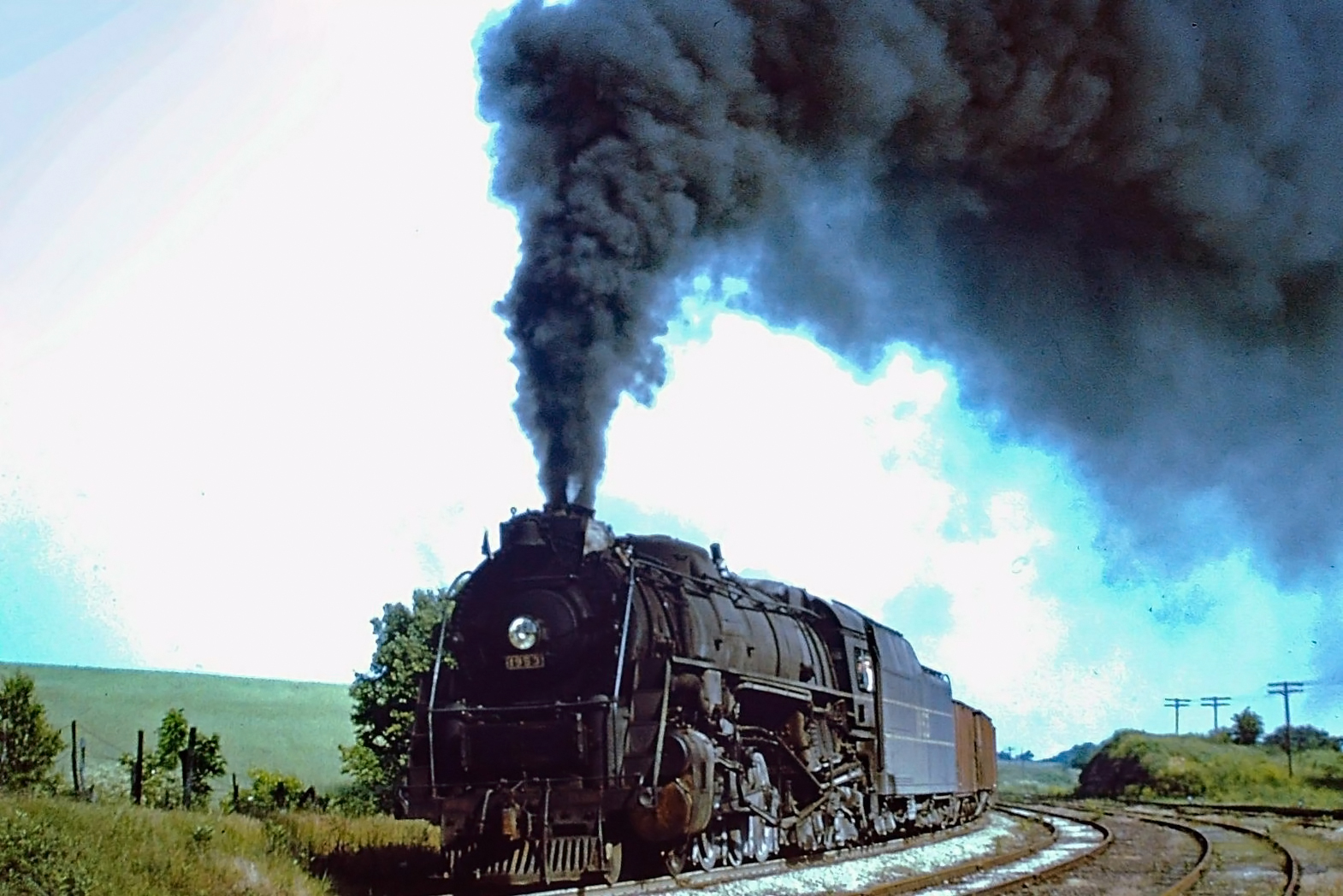 Louisville & Nashville 2-8-4 #1953, part of the M-1 class nicknamed "Big Emmas," steams through the Kentucky countryside near Winchester on June 5, 1956. None of these locomotives survive today.
Louisville & Nashville 2-8-4 #1953, part of the M-1 class nicknamed "Big Emmas," steams through the Kentucky countryside near Winchester on June 5, 1956. None of these locomotives survive today.Passenger Trains
During the height of rail travel the L&N was an important link for passengers either reaching the Gulf or East Coasts.
It worked with railroads such as the ACL, Florida East Coast, Pennsylvania, B&O, Southern, and others in this regard handling well-known passenger trains such as the Piedmont Limited, Crescent, and South Wind.
Of course, the railroad also owned a few notable trains of its own including the Pan American (Cincinnati-New Orleans) and Dixie Flyer (Chicago-St. Louis-Florida).
As traffic sagged after World War II it lost interest in these services, eventually abandoning its gorgeous livery of deep blue and rich vanilla for a much simpler scheme of grey and yellow. By the Amtrak era, which began on May 1, 1971, many trains had been discontinued.
Azalean: Operated between New York and New Orleans in conjunction with the Pennsylvania Railroad, Southern Railway, and Atlanta & West Point.
Crescent: Southern Railway's premier passenger train which operated between New York and New Orleans in conjunction with the Pennsylvania Railroad, Atlanta & West Point, and the L&N (which took it to New Orleans).
Dixie Flagler: Operated between Chicago and Miami in conjunction with the Florida East Coast Railway.
Dixie Flyer: (Chicago - Florida)
Dixieland: Operated between Chicago and Miami in conjunction with the Florida East Coast Railway.
Flamingo: (Cincinnati - Jacksonville)
Georgian: (Chicago - Atlanta)
Gulf Wind: (New Orleans - Jacksonville)
Hummingbird: (Cincinnati - New Orleans)
Pan American: (Cincinnati - New Orleans)
Piedmont Limited: Another of Southern Railway's passenger trains which operated between New York and New Orleans in conjunction with the Pennsylvania Railroad, Atlanta & West Point, and the L&N (which took it to New Orleans).
Southland: (Detroit - Florida)
South Wind: Operated between Chicago and Miami in conjunction with the Florida East Coast Railway.
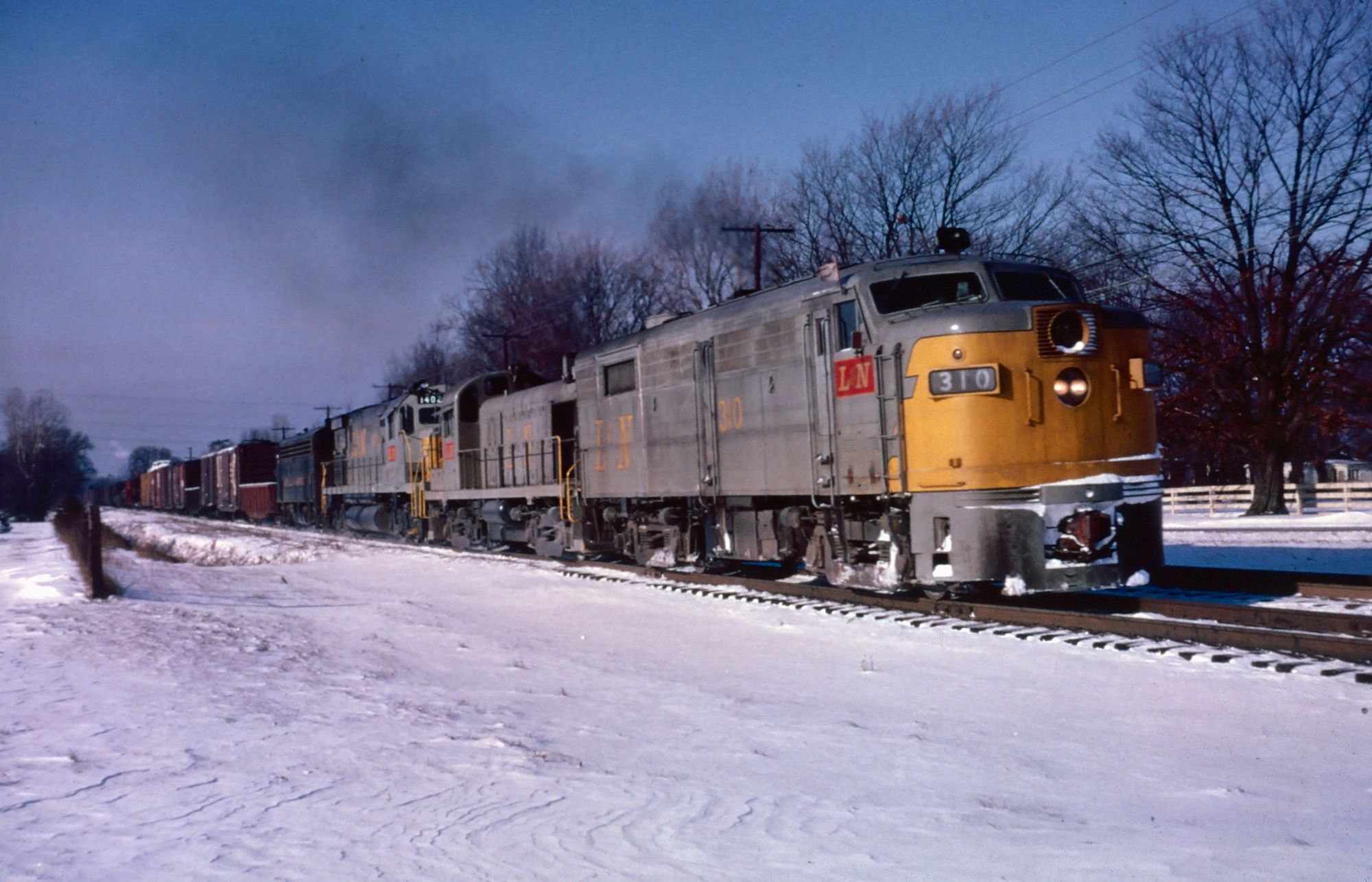 Louisville & Nashville FA-2 #310, an RS3, C628 #1402, and an F7A lead a manifest frieght near London, Kentucky on January 1, 1965. Photographer unknown. American-Rails.com collection.
Louisville & Nashville FA-2 #310, an RS3, C628 #1402, and an F7A lead a manifest frieght near London, Kentucky on January 1, 1965. Photographer unknown. American-Rails.com collection.Its key corridors were largely double-tracked including Cincinnati - New Orleans, Cincinnati - Atlanta, Evansville - Louisville/Nashville, and Memphis - Nashville - Atlanta. In addition, numerous secondary lines veered away from these main lines.
Its route mileage as of 1950 stood at 4,779 miles. The movement of coal always remained a key commodity. However, it also handled many types of other freight ranging from agriculture and forest products to merchandise and chemicals.
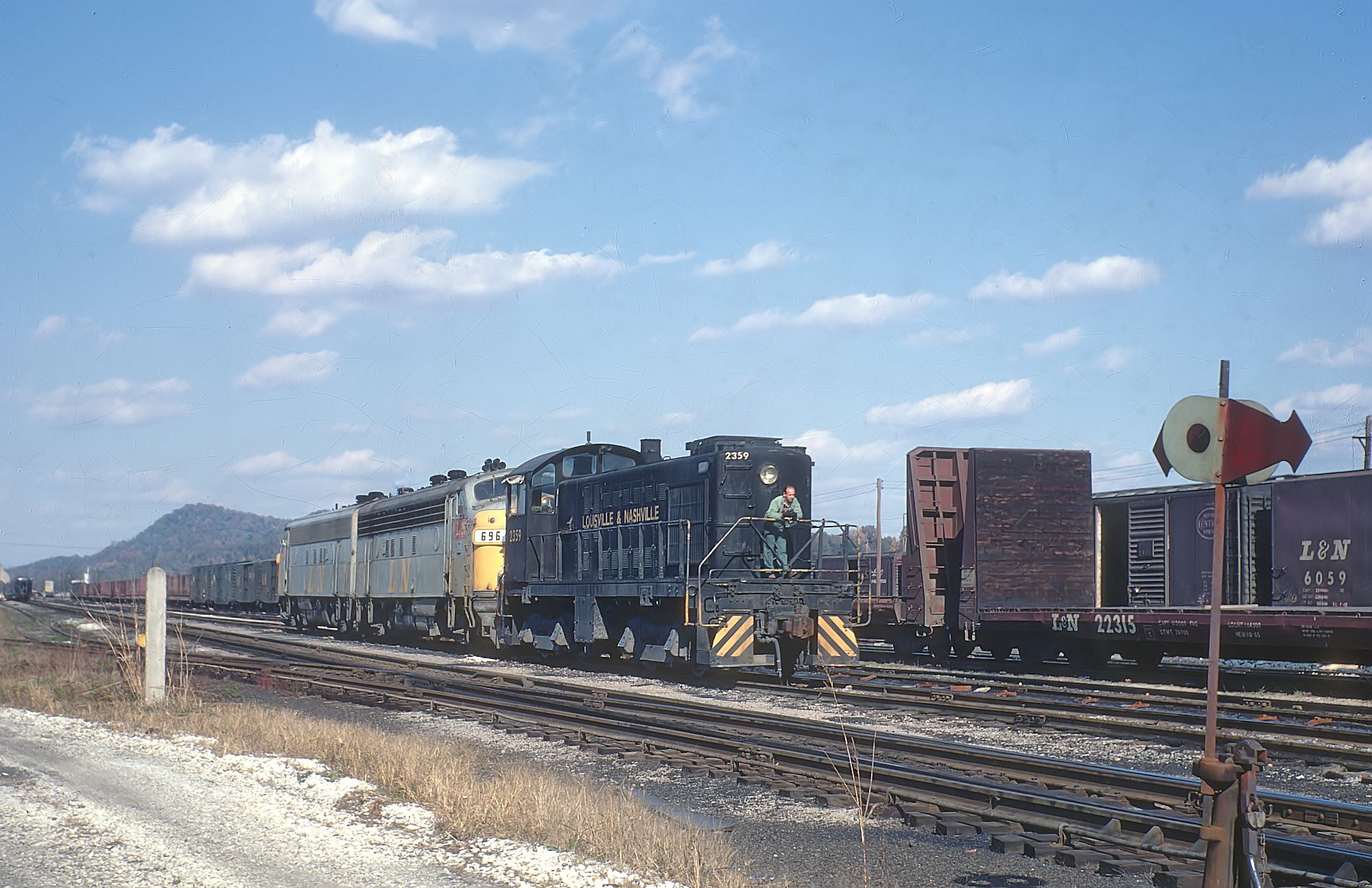 Louisville & Nashville S4 #2359, FP7 #696, and an F7, at Etowah, Tennessee in November, 1967. Rick Burn photo.
Louisville & Nashville S4 #2359, FP7 #696, and an F7, at Etowah, Tennessee in November, 1967. Rick Burn photo.Diesel Roster
American Locomotive Company
| Model Type | Road Number | Date Built | Quantity |
|---|---|---|---|
| HH-660 | 10 | 1939 | 1 |
| S1 | 16-19, 24-29, 34-68 | 1941-1950 | 45 |
| S3 | 69-75 | 1953 | 7 |
| RS3 | 100-179, 214-255 | 1951-1956 | 122 |
| FB-2 | 200-211, 330-331 | 1952-1956 | 14 |
| FA-2 | 300-321, 350-369, 383-384 | 1952-1956 | 44 |
| FPA-2 | 350-352, 383-384 | 1952 | 5 |
| C420 | 1300-1315 | 1964-1966 | 16 |
| C628 | 1400-1414 | 1964-1965 | 15 |
| C630 | 1425-1432 | 1966-1967 | 8 |
| S2 | 2200-2201, 2220-2224 | 1943-1949 | 7 |
| S4 | 2225-2232, 2350-2369 | 1951-1953 | 28 |
Baldwin Locomotive Works
| Model Type | Road Number | Date Built | Quantity |
|---|---|---|---|
| VO-660 | 20-23 | 1941 | 4 |
| VO-1000 | 2202-2210 | 1943-1944 | 9 |
Electro-Motive Division
| Model Type | Road Number | Date Built | Quantity |
|---|---|---|---|
| SW1 | 11-15 | 1939-1941 | 5 |
| GP7 | 400-440, 500-514, 550-552 | 1951-1953 | 59 |
| GP9 | 437, 441-459, 515-522, 553-554 | 1954-1958 | 30 |
| E6A | 450A-457A, 450B-457B | 1942 | 16 |
| E7A | 458A-461A, 458B-461B, 790-793 | 1945-1949 | 12 |
| GP18 | 460-464 | 1960 | 5 |
| FP7 | 600-634, 663-672 | 1951-1952 | 45 |
| F7B | 703-716, 900-902 | 1950-1951 | 17 |
| F9B | 717-720 | 1956 | 4 |
| E8A | 794-797 | 1951 | 4 |
| F7A | 800-858, 900-903 | 1950-1951 | 63 |
| F9A | 811, 919-926 | 1956-1958 | 9 |
| GP30 | 1000-1057 | 1962-1963 | 58 |
| GP35 | 1100-1115 | 1964-1965 | 16 |
| SD35 | 1200-1221 | 1965 | 22 |
| SD40 | 1225-1258 | 1966-1971 | 34 |
| SD40-2 | 1259-1278, 3554-3613, 8000-8033, 8067-8086, 8095-8126, 8133-8162 | 1974-1981 | 195 |
| SDP35 | 1700-1703 | 1965 | 4 |
| NW2 | 2240-2244 | 1949 | 5 |
| SW7 | 2245-2266 | 1950 | 22 |
| SW9 | 2277-2296 | 1951-1953 | 20 |
| SW1200 | 2297-2300 | 1957 | 4 |
| F3A | 2500-2501 | 1948 | 2 |
| F3B | 2550-2552 | 1948 | 3 |
| GP40 | 3000-3029 | 1966-1967 | 30 |
| GP38 | 4000-4019 | 1970 | 20 |
| GP38AC | 4020-4049 | 1971 | 30 |
| GP38-2 | 4050-4144, 6011-6044 | 1972-1979 | 129 |
| SD38-2 | 4500-4504 | 1975 | 17 |
| SW1500 | 5000-5029 | 1970-1972 | 30 |
| MP15DC | 5030-5039 | 1975 | 10 |
| MP15AC | 4225-4234 | 1978 | 10 |
| GP40-2 | 6600-6616 | 1980 | 17 |
General Electric
| Model Type | Road Number | Date Built | Quantity |
|---|---|---|---|
| 70-Tonner | 125-126 | 1948-1949 | 2 |
| U30C | 1470-1499, 1534-1582 | 1969-1972 | 79 |
| U25C | 1500-1517 | 1965 | 18 |
| U28C | 1526-1533 | 1966 | 8 |
| U25B | 1600-1626 | 1963-1964 | 27 |
| U28B | 2500-2504 | 1966 | 5 |
| U30B | 2505-2509 | 1967 | 5 |
| U23B | 2708-2772, 2800-2824 | 1973-1975 | 90 |
| B23-7 | 5115-5129 | 1978 | 15 |
| C30-7 | 7000-7015, 7032-7051, 7062-7069 | 1979-1980 | 44 |
Steam Roster
| Class | Type | Wheel Arrangement |
|---|---|---|
| B-0 Through B-12 | Switcher | 0-6-0 |
| C-1, C-2 | Switcher | 0-8-0 |
| D-0 Through D-21 | American | 4-4-0 |
| F-0 Through F-8 | Mogul | 2-6-0 |
| G-0 Through G-18 | Ten-Wheeler | 4-6-0 |
| H-0 Through H-29A | Consolidation | 2-8-0 |
| J-1 Through J-5 | Mikado | 2-8-2 |
| K-1 Through K-7 | Pacific | 4-6-2 |
| L-1 | Mountain | 4-8-2 |
| M-1 | Berkshire | 2-8-4 |
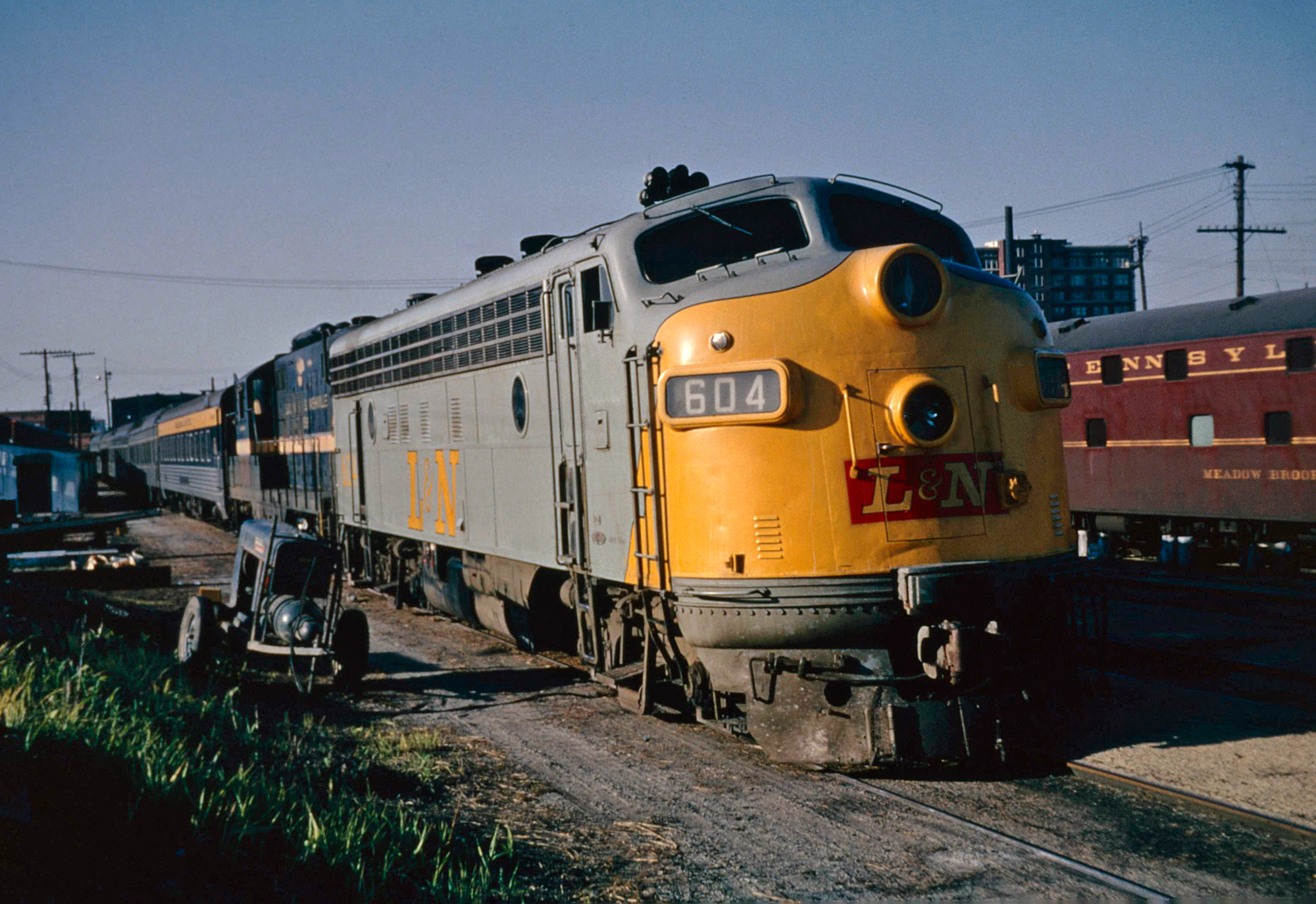 Louisville & Nashville FP7 #604 and a GP9 appear to be tied down with their train outside of Louisville Union Station on the afternoon of November 12, 1966. American-Rails.com collection.
Louisville & Nashville FP7 #604 and a GP9 appear to be tied down with their train outside of Louisville Union Station on the afternoon of November 12, 1966. American-Rails.com collection.Family Lines System
The 1970s signaled the end for the Louisville & Nashville’s independence. It had been controlled by the Atlantic Coast Line since 1902 and then joined the Family Lines System banner of the 1970s.
This marketing consortium included the then-Seaboard Coast Line, Clinchfield, and a number of other smaller lines. With this came a new livery applied to all railroads involved (with sub-lettering stenciled under locomotive cabs identifying each company) and gone was the L&N’s famous gray, yellow, and red livery.
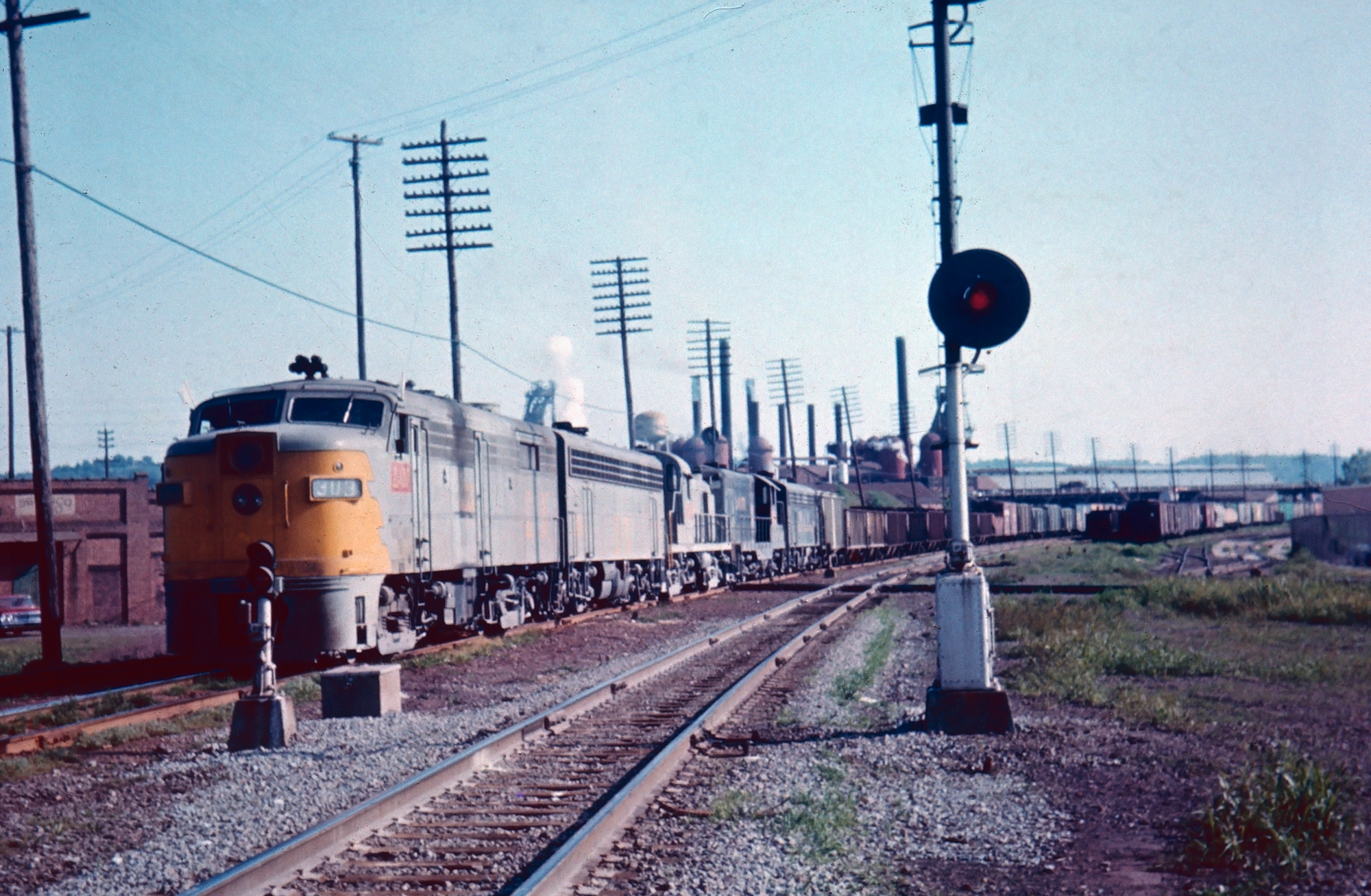 Louisville & Nashville FA-2 #303 leads a long freight southbound past the historic Sloss Furnaces at Birmingham, Alabama in the summer of 1965. Marvin Clemons photo. American-Rails.com collection.
Louisville & Nashville FA-2 #303 leads a long freight southbound past the historic Sloss Furnaces at Birmingham, Alabama in the summer of 1965. Marvin Clemons photo. American-Rails.com collection.CSX Transportation
As the 1970s gave way to the 1980s the L&N would officially disappear, dissolved through merger when the Family Line System officially became the Seaboard System in 1982.
This short-lived conglomerate helped the corporate transition into what eventually became the CSX Transportation banner, officially born on July 1, 1986.
The large Class I was formed largely through the Seaboard and Chessie System, which included the Baltimore & Ohio, Chesapeake & Ohio, and Western Maryland.
While the L&N is no more today the system and railroad it left behind continues as an important part of CSX’s southern lines.
Timetables (August, 1952)
Photo Gallery
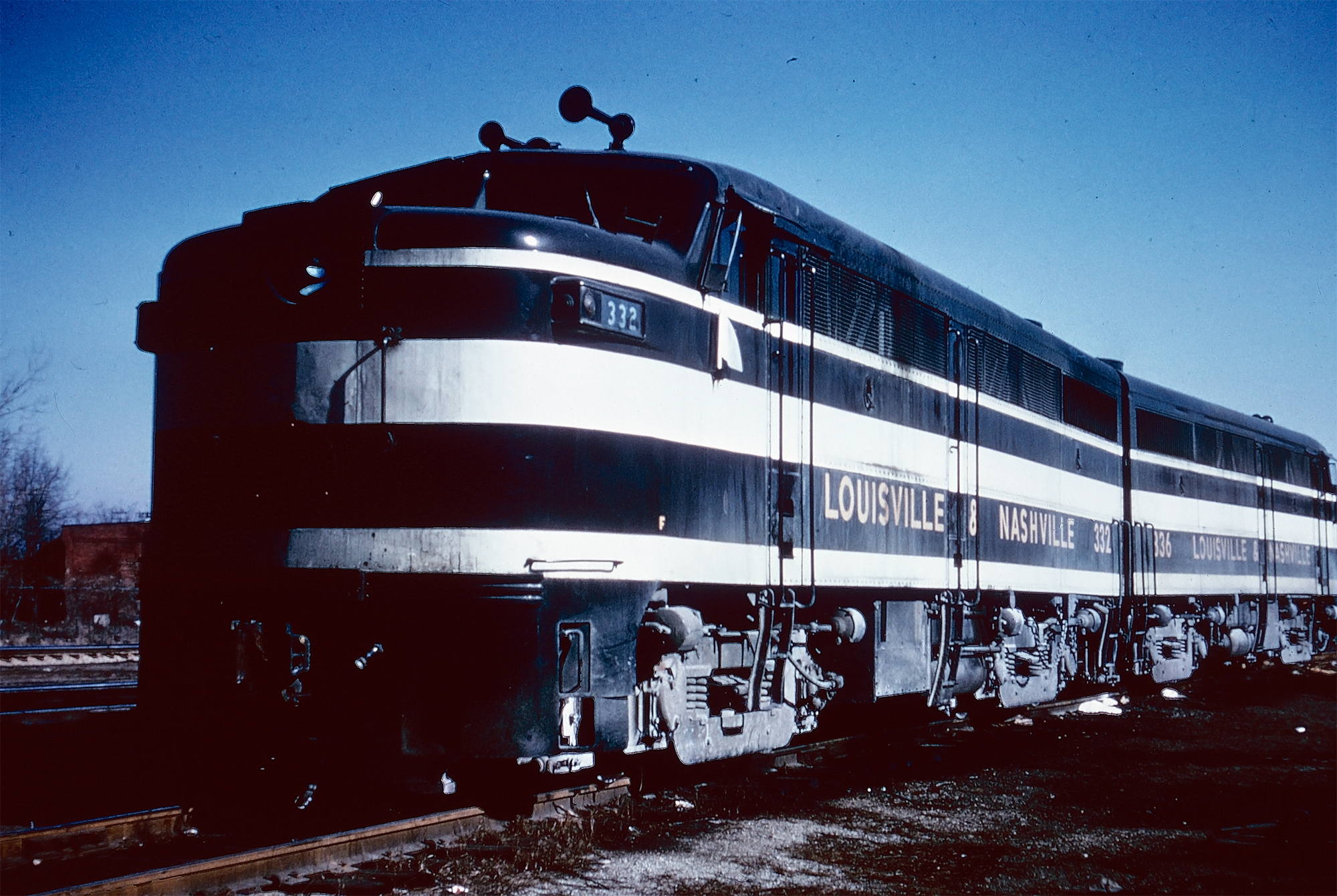 Louisville & Nashville FA-1s #332 and #336, acquired secondhand from the L&NE (ex-#701 and #705), circa 1963. American-Rails.com collection.
Louisville & Nashville FA-1s #332 and #336, acquired secondhand from the L&NE (ex-#701 and #705), circa 1963. American-Rails.com collection.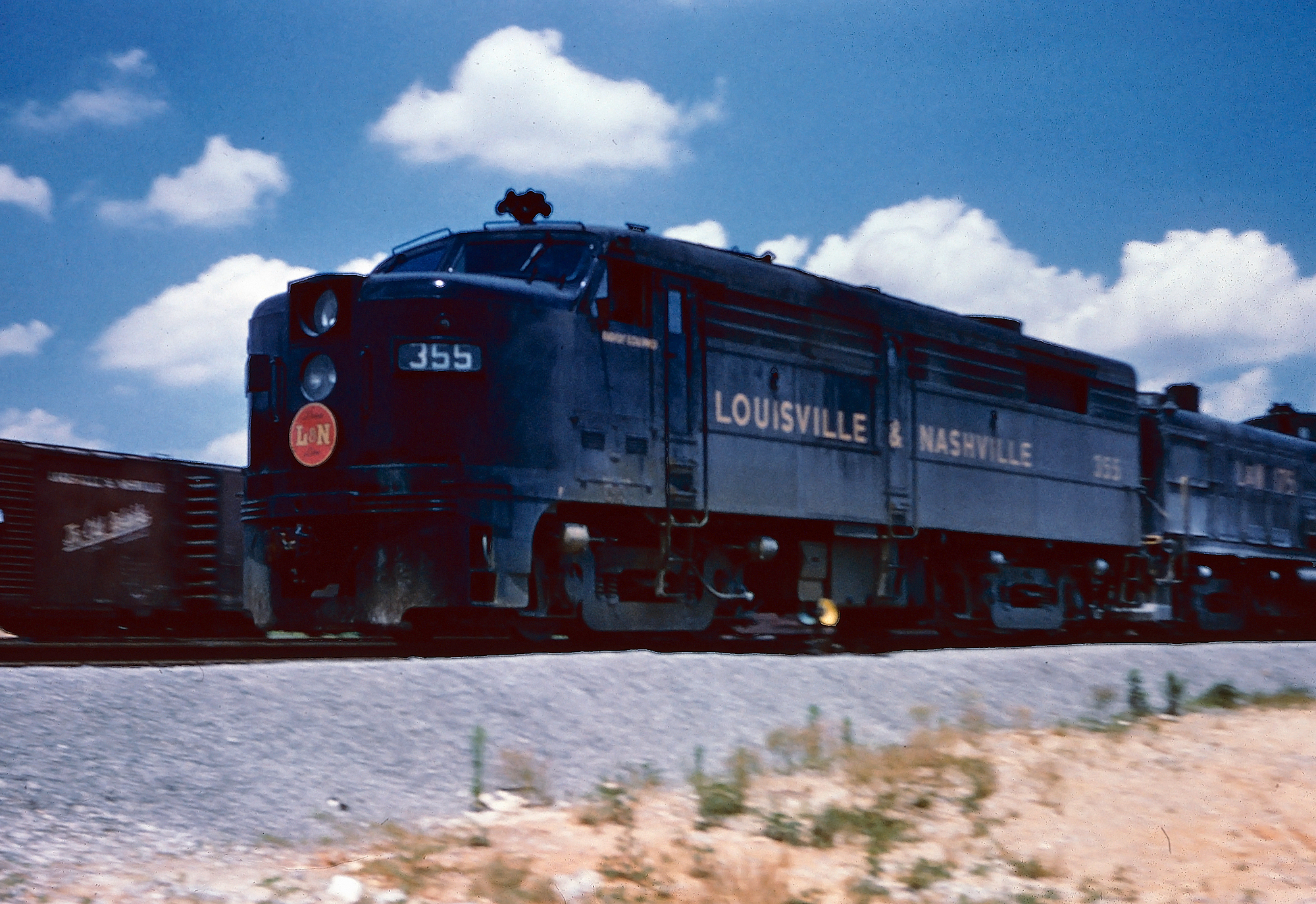 An earlier view of Louisville & Nashvile FA-2 #355 in service, circa 1960. Location/photographer not recorded. American-Rails.com collection.
An earlier view of Louisville & Nashvile FA-2 #355 in service, circa 1960. Location/photographer not recorded. American-Rails.com collection.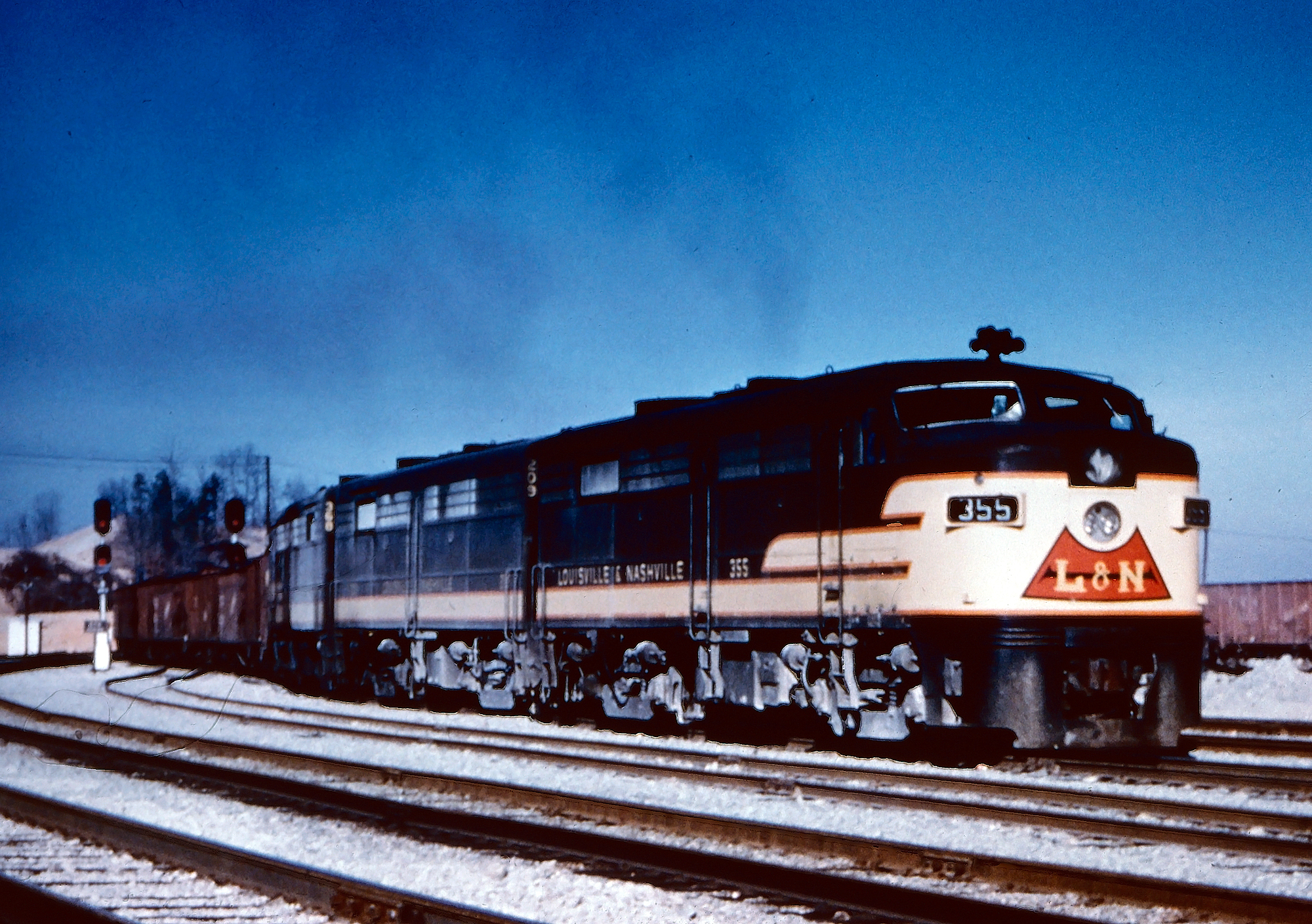 Louisville & Nashville FA-2s, led by #355, in their handsome, as-delivered livery are seen here in service, circa 1955. Location/photographer not recorded. American-Rails.com collection.
Louisville & Nashville FA-2s, led by #355, in their handsome, as-delivered livery are seen here in service, circa 1955. Location/photographer not recorded. American-Rails.com collection.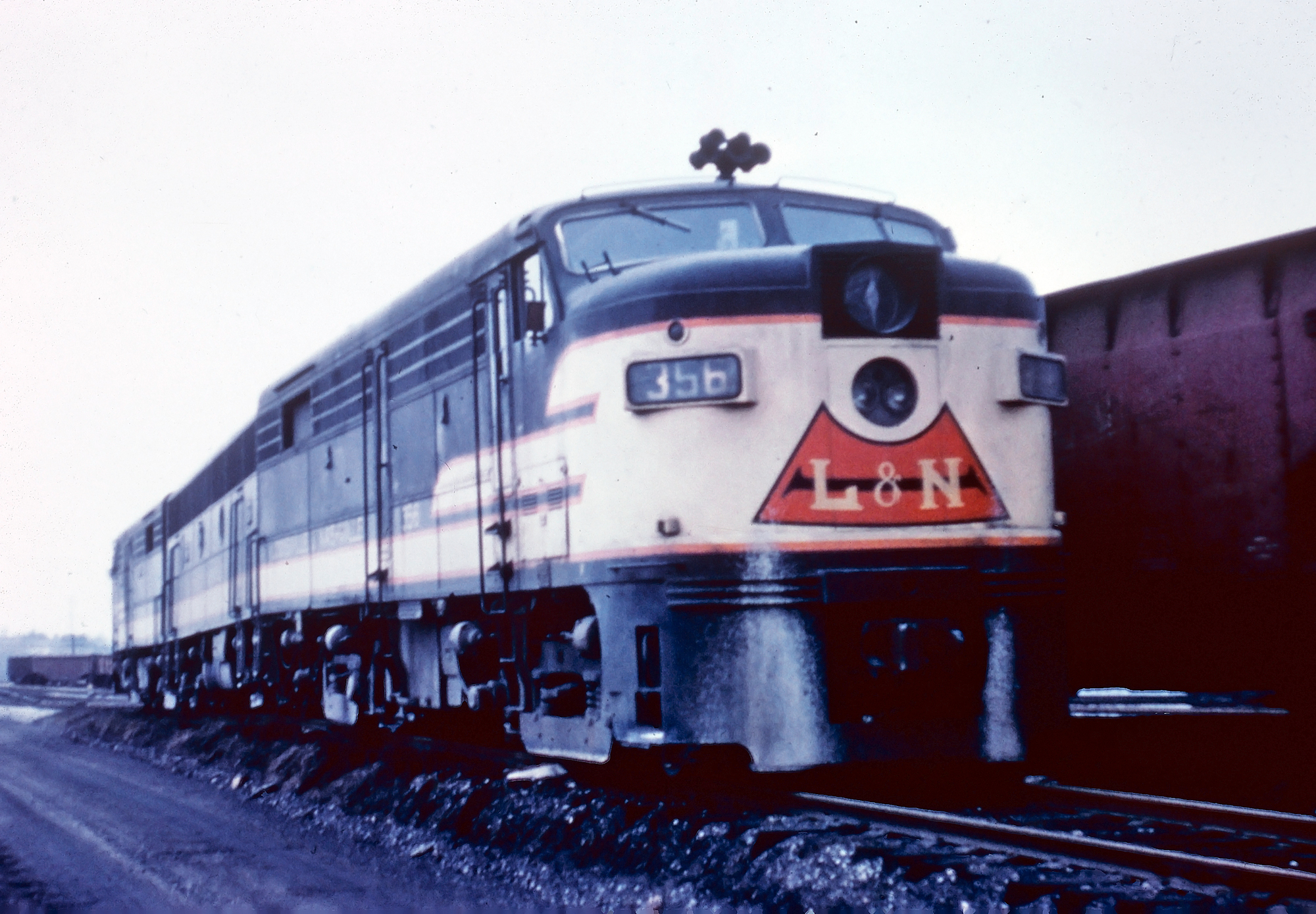 Louisville & Nashville FA-2 #356, and other power, circa 1960. Location/photographer not recorded. American-Rails.com collection.
Louisville & Nashville FA-2 #356, and other power, circa 1960. Location/photographer not recorded. American-Rails.com collection.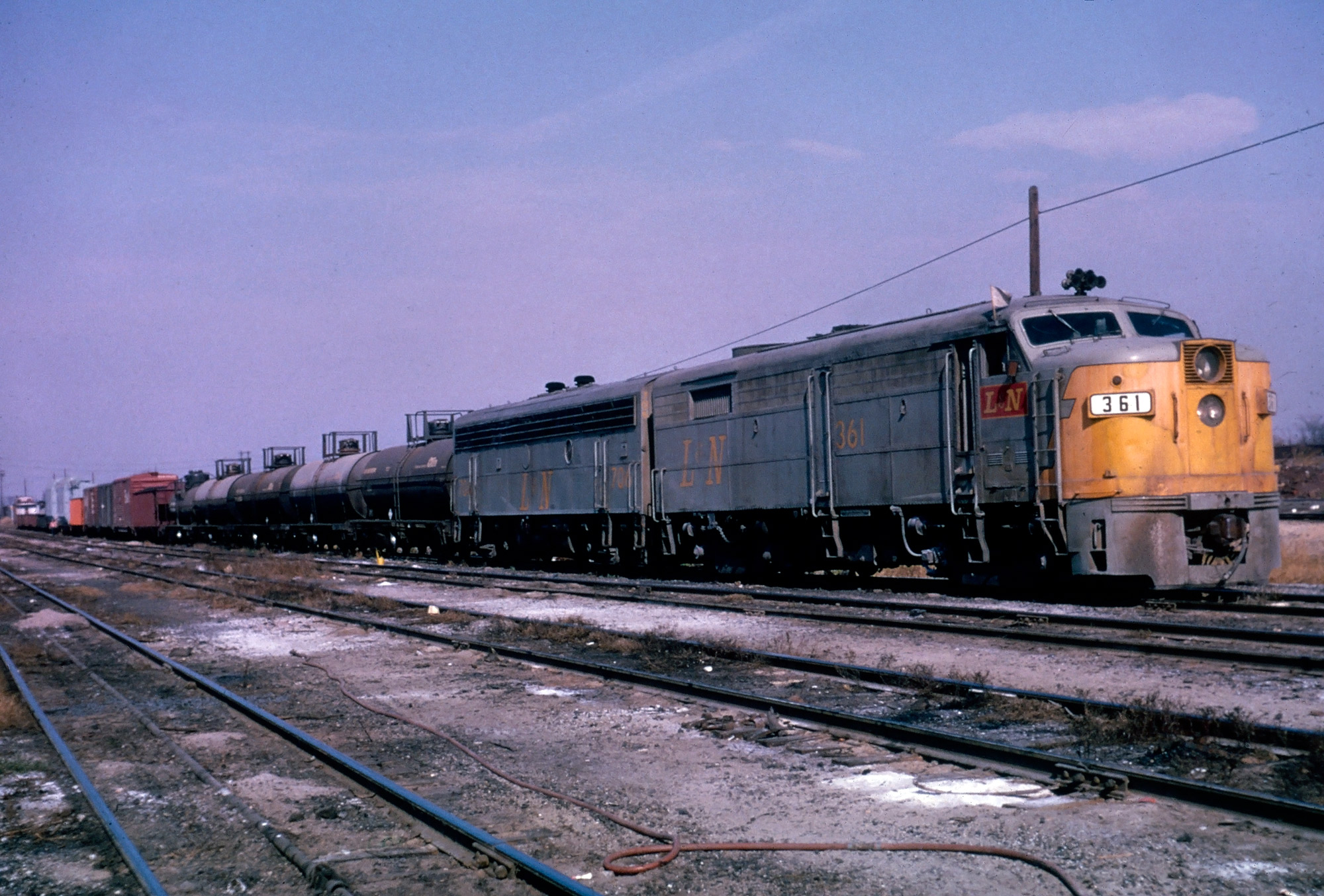 Louisville & Nashville FA-2 #361 and F7B #706 at Louisville, KY on November 6, 1965. Photographer unknown. American-Rails.com collection.
Louisville & Nashville FA-2 #361 and F7B #706 at Louisville, KY on November 6, 1965. Photographer unknown. American-Rails.com collection.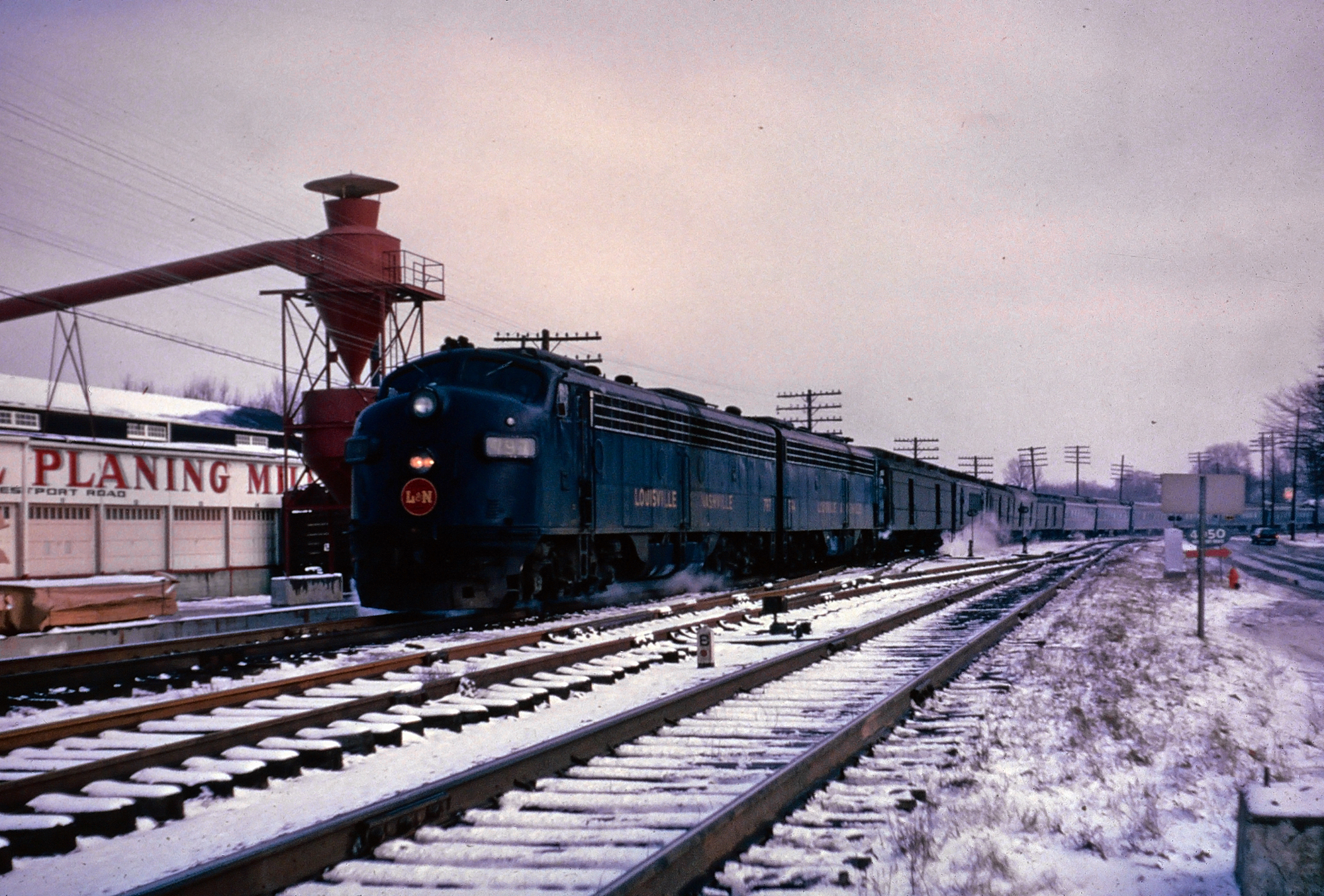 A pair of Louisville & Nashville E8As, led by #797, has an eastbound passenger train along Westport Road in Louisville, Kentucky, circa 1960. American-Rails.com collection.
A pair of Louisville & Nashville E8As, led by #797, has an eastbound passenger train along Westport Road in Louisville, Kentucky, circa 1960. American-Rails.com collection.Recent Articles
-
Florida Scenic Train Rides In Parrish!
Jan 11, 26 10:26 PM
The Florida Railroad Museum (FRRM) in Parrish offers something increasingly rare in today’s rail landscape: a chance to ride historic equipment over a surviving fragment of an early-20th-century mainl… -
California's - Wine Tasting - Train Rides
Jan 11, 26 02:28 PM
This article explores the charm, routes, and offerings of these unique wine tasting trains that traverse California’s picturesque landscapes. -
Georgia's - Murder Mystery - Dinner Train Rides
Jan 11, 26 02:07 PM
In the heart of the Peach State, a unique form of entertainment combines the thrill of a murder mystery with the charm of a historic train ride. -
Colorado ~ Murder Mystery ~ Dinner Train Rides
Jan 11, 26 01:43 PM
Nestled among the breathtaking vistas and rugged terrains of Colorado lies a unique fusion of theater, gastronomy, and travel—a murder mystery dinner train ride. -
Minnesota Dinner Train Rides In Duluth!
Jan 11, 26 01:32 PM
One of the best ways to feel the region's history in motion today is aboard the North Shore Scenic Railroad (NSSR), which operates out of Duluth’s historic depot. -
Illinois Dinner Train Rides At Monticello!
Jan 11, 26 12:42 PM
the Monticello Railway Museum (MRM) is one of those places that quietly does a lot: it preserves a sizable collection, maintains its own operating railroad, and—most importantly for visitors—puts hist… -
Alabama's - Wine Tasting - Train Rides
Jan 10, 26 09:29 AM
While the state might not be the first to come to mind when one thinks of wine or train travel, the unique concept of wine tasting trains adds a refreshing twist to the Alabama tourism scene. -
Maryland Dinner Train Rides At WMSR!
Jan 10, 26 09:13 AM
The Western Maryland Scenic Railroad (WMSR) has become one of the Mid-Atlantic’s signature heritage operations—equal parts mountain railroad, living museum, and “special-occasion” night out. -
Arkansas Dinner Train Rides On The A&M!
Jan 10, 26 09:11 AM
If you want a railroad experience that feels equal parts “working short line” and “time machine,” the Arkansas & Missouri Railroad (A&M) delivers in a way few modern operations can. -
South Dakota's - Murder Mystery - Dinner Train Rides
Jan 10, 26 09:08 AM
While the state currently does not offer any murder mystery dinner train rides, the popular "1880 Train" at the Black Hills Central recently hosted these popular trips! -
Wisconsin's - Murder Mystery - Dinner Train Rides
Jan 10, 26 09:07 AM
Whether you're a fan of mystery novels or simply relish a night of theatrical entertainment, Wisconsin's murder mystery dinner trains promise an unforgettable adventure. -
Missouri's - Murder Mystery - Dinner Train Rides
Jan 10, 26 09:05 AM
Missouri, with its rich history and scenic landscapes, is home to one location hosting these unique excursion experiences. -
Washington ~ Murder Mystery ~ Dinner Train Rides
Jan 10, 26 09:04 AM
This article delves into what makes murder mystery dinner train rides in Washington State such a captivating experience. -
Kentucky Scenic Train Rides At KRM!
Jan 09, 26 11:13 PM
Located in the small town of New Haven the Kentucky Railway Museum offers a combination of historic equipment and popular excursions. -
Washington "Wine Tasting" Train Rides
Jan 09, 26 08:53 PM
Here’s a detailed look at where and how to ride, what to expect, and practical tips to make the most of wine tasting by rail in Washington. -
Kentucky's - Wine Tasting - Train Rides
Jan 09, 26 08:21 PM
Kentucky, often celebrated for its rolling pastures, thoroughbred horses, and bourbon legacy, has been cultivating another gem in its storied landscapes; enjoying wine by rail. -
Kentucky's - Murder Mystery - Dinner Train Rides
Jan 09, 26 01:12 PM
In the realm of unique travel experiences, Kentucky offers an enchanting twist that entices both locals and tourists alike: murder mystery dinner train rides. -
Utah's - Murder Mystery - Dinner Train Rides
Jan 09, 26 01:05 PM
This article highlights the murder mystery dinner trains currently avaliable in the state of Utah! -
North Carolina Dinner Train Rides At NCTM!
Jan 09, 26 12:51 PM
Tucked into the Piedmont town of Spencer, the North Carolina Transportation Museum is the kind of place that feels less like a typical museum and more like a living rail yard that never quite stopped… -
Tennessee Dinner Train Rides At The TVRM!
Jan 09, 26 12:39 PM
Tucked into East Chattanooga, the Tennessee Valley Railroad Museum (TVRM) is less a “museum you walk through” and more a railroad you step aboard.

